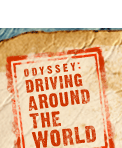November 13, 2003
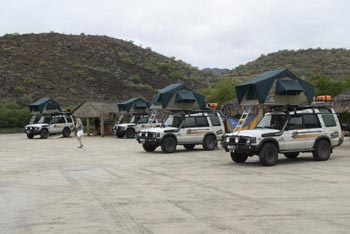
[Above: DATW vehicles camped on a beach south of Mulege, Mexico.]
Hello, blog readers. Nancy here. I've requested Thursday as my day to write blog entries during this expedition, so -- seeing as that they have obliged me -- you'll catch my chitchat right here each Thursday...
As you may already know, if Todd mentioned it in his Wednesday blog, we pulled into camp last night at around midnight-thirty. The night driving and winding roads, combined with the late hour, meant nobody was really up for anything more than popping the tents and hitting the sack. I fell asleep to thoughts of a warm shower (as promised by signs posted in the camp ground) after a brisk run along the ocean. We set up our tents in a place called Guerrero Negro, in a camp ground next to some Mexican military barracks. The nights are pitch black here in Baja, but I was pretty sure we had parked only a few hundred yards from a serene beach.
We'd agreed to hit the road at 0830, so I had set my alarm for 0715 in order to run. Every day since we started this expedition, Todd has said to me, "Oh, you ran? I thought about running." He had stated his intentions so many times with zero follow-through that I figured he was a lost cause. But he surprised me today.
At 0530 this morning, we were awakened to the sound of a crazy mariachi band's horn section practicing ruffles and flourishes for about an hour. After some broken sleep, we were again awakened at around 0700 to the familiar (to this Marine, anyway) sound of troops counting cadences. Exercicios, anybody?
I did get up when my alarm sounded at 0715, but, had I somehow managed to sleep through it, Adam's arrival at the door to our roof-top tent with camera in-hand would have rousted me. He was filming our sleepy wake-up for the documentary...he definitely captured the real Nancy - puffy morning-eyes and all.
I stuck my head out of the tent to realize with horror (ok, it wasn't horror, exactly, but I was definitely surprised) that we were nowhere near a beach, or even a body of water, but smack in the middle of a vast desert. Ugh. Where would I run without fear of being kidnapped for ransom? Around and around the camping compound?
To my surprise, Todd asked what time it was and then said he'd like to run with me. We took off down a dirt road toward what turned out to be a tiny little pueblo. It was his first run of the season, and we were both tired, so we agreed to a mere 20 minutes. Eventually, I tricked him into running an additional 24 minutes by suggesting it would be a good idea to see if we could make it all the way to the cement barrier at the end of our dirt road. "I like goals," he said. What a great sport he is! We didn't make it, but we did cover some valuable extra distance. On our final leg to the finish, Todd and I agreed that I will do a "Brandy Chasteen" victory hurrah to celebrate my 50th run of the expedition. I'll run into camp, strip down to my sports bra, and throw my arms up in declaration of my #1 status, simultaneously dropping down to my knees in victory while the significance of the moment overwhelms my senses and sensibilities. I can hardly wait. It will be very, um, spontaneous.
We started driving at precisely 0830 - an amazing accomplishment for this team of late sleepers, dawdlers, and procrastinators. I barely made it in time, because the warm shower I had been dreaming of turned out to be ice-cold and miserable. I couldn't stand the cold long enough to wash my hair, so I ended up washing it in the sink...
Todd and I (we are in command of Vehicle D3) had a lovely conversation about the meaning of "a sense of urgency." (His take: "Not something that's real important to me a lot of times. Depends on what it is." My take: "It's absolutely critical to survivability and mission accomplishment." Our take: Move on to a new subject, promising to resume the conversation later, and knowing full-well that Nancy will continue to avoid it from now until the end of time.)
At about 1040, we passed a Mexican gentleman broken down in the middle of the road, and Nick announced over the radio that he was turning around to help him. We had decided that no vehicle was to go anywhere solo, so Todd and I announced we'd go with Nick (Todd is a mechanic).
We quickly radioed the other two vehicles to continue on to a town called San Ignacio and await our arrival. Ten minutes later, after dumping half a jerry can into Luis' empty Chrysler, we were back on the road and heading to San Ignacio to rendezvous with the crew.
Three hours later, we were still trying to rendezvous with the other two vehicles...We had blown right past San Ignacio, not realizing the little buildings and taco stands along the side of the road were the city, and ended up in San Rosalia on the coast...about 75 kilometers beyond San Ignacio and our team. After a loop through town to scout for their vehicles, we turned around and drove all the way back to San Ignacio. Man, those guys were going to be pissed. We prayed they'd decided to have some cervesas and margaritas.
The trouble was, there was no sign of them in San Ignacio. So we turned around and drove all the way back to San Rosalia. Still no sign of them. We were feeling pretty hungry by then and pulled into a roadside restaurant along the main drag for some tacos. A few minutes after we ordered our tacos pescados (fish tacos), D2 and D4 pulled into the lot beside our vehicles. What a happy moment that was! Everybody was safe and sound and back together. To our surprise, they were coming from the direction of San Ignacio.
We'll never know how we missed each other, but the good news was we were reunited at last. Surprisingly, nobody was too mad, and nobody tried to point fingers and place blame. They had had tacos in San Ignacio before driving back to where Luis' car had been stranded, and had finally decided to head on down the road to our destination for the day, Mulege. Meanwhile, we had figured they were probably already drinking beer on the beaches of Mulege. It would have been awesome to see a bird's eye view of the four vehicles doing circles and narrowly missing one another at every turn. I'll bet it would be pure comedy to see from above.
We finally got on the road again after gassing up and bickering over what we perceived to be an overpayment scandal at the pumps in San Rosalia. The time was almost 1730, and 1.5 hours separated us from Mulege. That meant more driving at night on winding roads. Our intended protocol called for no driving at night...
We found the campground fairly easily, and we were excited to have a strip of beach and a private lagoon all to ourselves. Life was good! We were in the rack by 2330, and my alarm was set for a 0830 run. Tomorrow would be a late departure, with just an 80-kilometer drive to our destination in Laredo on the slate for Friday. Life is good.
| Logbook for November 13th | ||
|
Start: Guerrero Negro, Mexico Time: N: E: |
Finish: Mulege, Mexico Time: N: E: |
Mileage: 250 |
November 14, 2003
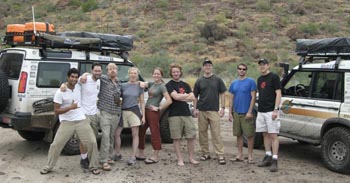
[Above: The Drive Around the World team is all smiles after offroading near Mulege, Mexico.]
Whatup folks?
So, I'm chilling down here in Mexico in a town called Loreto, having a blast. Pretty soon we'll be heading across the sea of Cortez to Mazatlan for a day and then head across to Mexico City, where hopefully we can pick up my friend Rebekka and then see some more Mexico, with a Mexican to guide us. Anyhoo, i have to run.
Rock on.
Colin@drivearoundtheworld.com
Editor's note: For an mp3 audio update from Colin "Corndog", click here.
P.S. - Drove south along the Bahia Conception past stunning desert scenery. Spent several hours filming and off-roading. It was our first low-mileage day since entering Mexico, and we were able to enjoy a night on the town in the sleepy burg of Loreto.
| Logbook for November 14th | ||
| Start: Mulege, Mexico | Finish: Loreto, Mexico | Mileage: 75 |
November 15, 2003
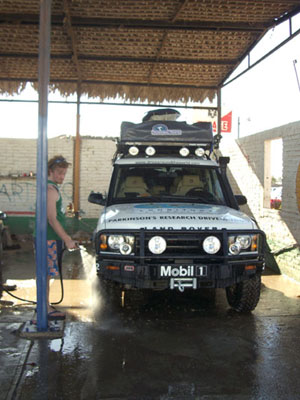
[Above: Drive Around the World videographer Colin "Corndog" washes a vehicle near Ciudad Insurgentes, Mexico.]
Today started as any other day with Drive Around the World - running late. Although the team had plenty of time to rest up overnight, the ability to execute our schedule on time seems to elude us in one way or another every day. We woke up to a beautiful, sunny day in the quaint town of Loreto, Mexico. A sleepy bungalow village of approximately 10,000 people settled in the mountains on the western edge of the Gulf of California, it is a place I would like to visit again in the future. The roads leading into and out of Loreto are a dream ride. After we complete the expedition, I would like to bring my motorcycle down here for at least a week. The gentle curves are embraced by rocky terrain and the blue water in the distance plays peek-a-boo with the guests on the highway. It is enough to take your breath away. The village itself is subdued. Quaint restaurants and curio shops line the streets of the main square, and an old church serves as a sentry guarding the town center. Perhaps it is the beauty of the places where we are staying that holds us captive and unwilling to depart without a long last look. Perhaps.
Our route today carries us further south on Mexico 1 to La Paz, where we will catch a ferry to Mazatlan tomorrow. All told, it's a relatively easy drive of 220 miles today. Rolf and I start by strategizing how we can make up time and better manage logistics so the team operates more efficiently. It's a conversation we've had before. In fact, we were still having it as we pulled into La Paz for dinner about an hour ago. Just a quick example of why being efficient is so important - we have 9 members on the expedition. The expedition is roughly 270 days long. If we waste 20 minutes every day of the expedition, we will have wasted 810 hours. That equals one month. You can see why this is so important to us.
We stopped for a bathroom break after about 90 minutes of driving. As we were stopped, we started thinking about the upcoming Agricultural inspection that we'll be subject to in Mazatlan. Now, if you've ever been through one of these (this will be our second), you know it's pretty much crap. The officials look at your car, spray it with some unknown fluid (which smells awful - hold your breath), and charge you a fee for passing through. I've seen plenty of scams in my life, and this one fits the description on all accounts. One thing though, when entering into another country, it seems that the cleaner your car is, the less likely it is that you'll be hassled. Normally for our crew, that's not a problem since the cars stay pretty clean. We're always showing them off to people, and we like to represent our mission well. But now that we've left the states, our standards are slightly lower. Yesterday morning, just for fun, we decided to take the vehicles off-road through some mud for the benefit of the film crew and our own guilty pleasure. These things are filthy. Mud caked on, in, under, and around just about every conceivable place. So, now we have to wash them. Thanks to some directions from a small boy and a bicycle escort from him and his friend, we found ourselves at a Mexican car wash. Basically, a garden hose. About an hour later, we were off again.
Just south of Cuidad Insurgentes, a question crackled across our radios. "Has anyone noticed the large grassy balls growing on the power lines outside?" We both stopped mid-sentence. "What?" we thought. So, we put our conversation on hold to peer out the window at the power lines whizzing past our vehicle. Sure enough. There are these round, grassy growths on the power lines. There's no real consistency to their placement or size, but there they are. "What could they be?" we wondered aloud. Suddenly, everyone's guesses are broadcast for the team's enjoyment. "I think they're bird's nests," someone offered. "I think grass seeds are left on the wires by birds after they poop and grass grows," someone else joked. Rolf and I offered our own thoughts, which included theories with termites, cows that projectile defecate, and others silly thoughts that don't warrant mentioning here. At last, Nick and Chanda offered something along the lines of birds building nests in those locations because the wires are slightly frayed and it offers additional heat for the baby birds. "Hmm....makes sense" we both said. Then Adam made the same suggestion. As did Rolf. The battle was on to claim ownership of this idea, when in fact I don't think any of us really knows. If anyone out there does, please email justin@drivearoundtheworld.com. I'd love to add this bit of information to my endless collection of useless trivia.
So now, it's 9:17 and we're in La Paz. We've actually been here for over an hour and as soon as we wrap a few more things up, we're going to head north of the city to camp out. We've had dinner (tacos again), seen parts of Forrest Gump in Spanish, written some emails, stepped in dog crap (well, that was just me), and seen a wedding party and the cake in the back of a pickup truck go by. Tonight, we're camping on a beach called Tecalote. Which means it'll probably rain. At least, that's what has happened the last 3 times we've camped at the beach. I wonder at times if we aren't rain gods. So, if you live someplace on a beach where it's not raining, let me know. I'll be right there with 8 of my friends.
Oh, and if you serve us dinner, we're up for anything. Except tacos.
| Logbook for November 15th | ||
| Start: Loreto, Mexico | Finish: La Paz, Mexico | Mileage: 225 |
November 16, 2003
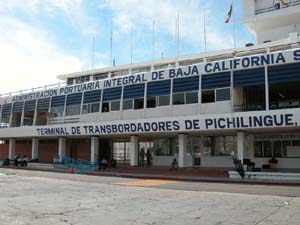
[Above: The ferry terminal in La Paz, Mexico, where we spent the good part of a day trying -- unsuccessfully -- to get our papers in order.]
No one at this morning's briefing would have known that at 2:45pm today Justin, Nancy, and Neil would become the proud owners of LONGITUDE Expedition vehicles.
We got up early this morning with a plan. We would rise at 9am at our beach front camping grounds, pack up our Hannibal tents and head down to the Port of La Paz. Today we ship to Mazatlan. This would be the first of many ship dates for us.
Some of us had shipped vehicles from La Paz before. We knew that the process was pretty straightforward...you drive up to the port, show some official-looking paper work, weigh the vehicles, pay, and board a giant colorful ship that would float you for 15 hours across the Sea of Cortez.
Most of that did happen today. We drove up to the port and showed our official looking paperwork. While Nick, Todd and Neil were showing off this paperwork to the port authorities the rest of us hung out in the Port of La Paz parking lot. There we met a friendly globe-trekking Canadian couple who told us that they had been trying to ship their vehicle for three days but because of unexpected paperwork and lack of proper rubber-stamped pages, they had been turned away each day. Every day a curve ball was thrown their way, and today's curveball required a stamp on their tourist cards from, of all places, a bank.
Even after hearing the plight of the Canadians, we didn't think that we would have a problem boarding today, we had, after all, called a head for reservations and made sure that our paperwork was in order. Or did we...? We even sent in the Ôbig guns' to negotiate the shipping details---Nick, our charming and persistent leader, Todd--our good will ambassador and negotiator, and Neil--our bilingual ace in the hole.
The ship to Mazatlan sails everyday around 3pm, it was noon and we were still waiting for Nick, Todd and Neil to emerge from the Port Authority office. No problem though, we had 3 hours before the ship sails. Around 2:30pm, just when those of us who were left to amuse ourselves in the parking lot started to get a little antsy, Todd came bounding out of the PA office and headed straight for the "office box". The office box is one of Nick's ideas, it's a large box with all of our office supplies, including all the little stuff like paper clips and scissors, it also includes software and cables, and, holy cow!, a color printer. It was one of those ideas where you know it's silly and impractical but you smile and nod just the same thinking the one behind the idea will come around to your way of thinking on their own. Anyway, Todd was headed full speed to the office box. A curve ball had been thrown and now we had an assignment.
The vehicles are registered to Drive Around the World, and only the registered owner of the vehicles can drive them on mainland Mexico... makes sense in a way, but who knew? Our assignment was to create and print up official looking documents that authorized other members of the team to drive vehicles that belong to the organization. The documents were created in minutes -- they included authorization from Nick, driver names and passport numbers. Only twenty minutes to go. Time to print. A statement that is, in my experience, easier said than done -- especially when you are printing out of the back of a car in a Mexican sea port parking lot. It was as if the printer sensed our urgency and panicked. Each page out of the printer looked like the baffles of an accordion. 15 minutes and three Drive Around the World printer repair technicians later, we had our official looking documents.
Todd ran them into the PA office with just minutes to spare. The documents were perfect, we got the thumbs up from the PA folks and they would have accepted them had they been notarized... ugh!
It was Sunday and all of the notary offices were closed. 5 minutes before the ship departed, most of us had resigned ourselves to staying in La Paz an extra day and being another day off schedule...until Nancy suggested that we sign over the vehicles to three team members. Brilliant! Off we went back to the PA office, pen in hands.
The PA supported this plan so we signed the vehicles over to Nancy, Justin, and Neil. Ran the paperwork over to the Banjercito, which is across the parking lot. The Banjercito is the only place in Mexico that is authorized to approve temporary import of vehicles into Mexico. All of us crowded around the walk-up window of the Banjercito expecting to find a friendly Mexican lady waiting to help us and not the red and white plastic sign that read "Cerrato". The Banjercito closed at 2:30.
Okay, so we sail tomorrow...or do we?
------------------------------------------
Travel tips:
For temporary vehicle import into Mexico, the following paperwork is required:
--Original vehicle titles for each vehicle (+ 3 copies)
--Vehicle registration (+ 3 copies)
--Three copies of each driver's passport, driver license, and tourist card
--One copy of each driver's credit card
--Notarized letter, authorizing each driver to drive the organization's vehicles (+ 3 copies)
--This paper work must be provided to Banjercito. The fee was 336.50 pesos per vehicle.
--The Banjercito closes at 2:30pm.
| Logbook for November 16th | ||
| Start: La Paz, Mexico (Tecolote Beach) | Finish: La Paz, Mexico (Tecolote Beach) | Mileage: 37 |
November 17, 2003
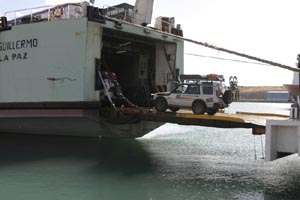
[Above: Drive Around the World vehicles finally make their way onto the ferry bound for Mazatlan.]
The ferry, the ferry -- the dang ferry!!! I guess from all the traveling I have done in my life, I shouldn't have expected anything less than our wonderful experience at the ferry terminal in La Paz. As you read yesterday, we couldn't get on the ferry because our vehicles were all under Nick's name. It is the law here in Mexico that as a tourist on a tourist visa, you may only drive one car in Mexico. We have four, and they are all registered and owned by Nick, so they wouldn't let us on the ferry. After trying to talk to the officials and deal with them all day yesterday, we came to the conclusion that we had to get three documents signed by a notary stating that Nick gave us permission to drive the other three vehicles. We could have also just transferred the title over, but by the time we figured that out, the person who gave out the car permits was already gone for the day.
So anyway, today, Monday, I awoke in our roof tent to a very gorgeous sunrise and the wind blowing about 15 knots right through our tent. It was a refreshing breeze, keeping away all the gnats, no-see-ums, and mosquitoes, and blew in through the front of our tent and on out the back. It was a slice of heaven, about 65 degrees outside, and the sounds of the lapping ripples of the Sea of Cortez filled the air. I had just awoken from a wild adventurous dream of swinging on vines through foreign lands and chasing down the evil in the world.
So there I was, just gazing into the sea and white sand and soaking in a few minutes of the blissful surroundings. A few moments later, Justin walked up and said hello and told me that we needed to get ready soon to head into La Paz and deal with obtaining our notary signatures. This was our agenda for the day. It seemed pretty simple, go to La Paz, find a lawyer, hand her over the papers, get the stamps, and go to the ferry terminal and get on the boat.
Well, in Mexico, nothing is simple -- or then again, some things are so simple that people don't think to send you in the right direction ahead of time, thus carving an extravagant maze out of what should have been one single square hedge.
Nick, Nancy, Justin and I drove to La Paz and headed toward one of the plazas in the center of town, looking for a lawyer's office. One police officer told us there was one in a building nearby, which of course wasn't correct. But after going into the building and interrupting a meeting, the perturbed lady told us where we could find one. So off we headed, and of course didn't find that one, but finally spotted another and walked inside. The woman inside of this office told us to go down the road another few blocks, where we would see a notary office. We got back in our vehicle and we finally did spot the notary. Yeah!!
We were excited, and we were on schedule and things were going well. Once inside, the lawyer, a woman, came up to us and I explained to her what we needed and she looked at our documents. "I am sorry, but you have to have these documents in Spanish." Now, the frustration really started to settle in our veins. Not only did we have to translate our documents, we couldn't do it there at her office. And we were on a time crunch!
Luckily, there was an Internet cafe a block away, so we ran over there and began to translate our documents into Spanish. This was going well -- we were a bit stressed about time, but it was going all right. But then we hit the print button, and the printer didn't work. Are you kidding me?! This is too funny. The two ladies at the counter tried unsuccessfully for ten minutes, then their boss came out and after another ten minutes, he finally got the printer running.
So we printed one off, and I ran off to the lawyer's office to make sure this document would do. When I got there, it was a madhouse. There were four ladies walking around, one with headphones talking to someone on the phone and trying to appease a customer at the desk at the same time. The other ladies seemed to be occupied with other things, like telling one of their sisters what groceries to buy. Literally, there were people waiting, and some woman walks in to the office, past the entrance, wearing tight sweats, and the lawyer stops what she is doing to hang out with her friend and discuss groceries.
The lady who I had spoken with earlier kept looking at me, but did not acknowledge me. Finally, after waiting patiently I asked politely, and loudly, in Spanish of course, "Could you please just let me know if this document is OK so I can go tell my team to finish the others?" Thank goodness, it was legitimate.
I ran back over to the Internet cafe and told Nancy we were good to go. She finished off the documents and we all scurried back over the office. Once inside, the lady came up to us and took our documents and asked us for some other forms of I.D. and the process began. Now I thought that getting a few notary stamps would take a few minutes, but of course, we are in La Paz and things move at a much slower pace here. So after 20 minutes of waiting, she told us it would take until the afternoon to finish. I didn't accept that and told her we needed to be at the ferry terminal 30 minutes ago already!! She shrugged her shoulders and gave me a helpless look, then turned to her superior, and yee-haw, she said they could do it in 15 minutes. Well, the next 30 minutes that it actually took seemed like eternity, as Nick fell asleep sitting up in his chair, and Nancy chewed on her sugarcane she picked up out front, and Justin sipped on his warm Coca Cola while writing in his journal. I started taking photos, and the lawyer got embarrassed and smiled and lightened up a bit. Deep down, she loved to be on film -- who doesn't? It was funny.
So finally, we paid $100 for the three notaries and we were off, about 2 hours behind our original plan. When we arrived at the ferry terminal, we went up to the window to receive the car permits, and there were actually no problems. However, we then learned that the ferry that was supposed to run wasn't running anymore. They had decided to clean it today, since the cargo wasn't that large. Are you kidding me? Oh well, I guess we will just have to stay our third night in La Paz and chill out and drink more cerveza.
As luck would have it, at the other end of the docks there was another cargo ferry that was leaving in a few hours. I went a researched it and sure enough, there was a ferry leaving at 5 pm. Perfect.
So we all proceeded to eat some roadside tacos, yummy cookies, and wait another hour to get through the car permit line. Then we passed through customs, paid $200 per vehicle, $40 per person and drove onto the ship.
We were all so stoked to be on this ferry. It would have been another day's delay otherwise. We have to be in Panama on a certain date, and each delay we have cuts into our days off for relaxation.
The ship we are on is a big cargo ship. There is one room inside the boat on the third deck with airline seats set up like an airline, literally. There is a TV at each end of the room, and they have DVD's they play. We started with American Pie 2. We each received two meals with our ticket purchase, which is nice. We had beef, rice, beans and tortillas for dinner.
I went out to the front of the ship and watched the crewmen reel in the anchor and started talking to them and taking pics. They invited me up to the "bridge" where the captain and some pretty ladies were. I hung out up there for a little while and chatted with some Pazenos. About two thirds of the team were set up in the airline seats writing and working on their laptops.
Colin, Adam and I are drinking a few Modelo's and chilling. We are about to go throw a ceremonial "dreadlock" off the edge of the boat into the sea, as Colin spreads his locks all over the globe.
So that's it for today. I could write more, but I think this is too long already for our daily blogs.
Monday is my journal day -- cheers to Monday!
| Logbook for November 17th | ||
| Start: La Paz, Mexico (Tecolote Beach) | Finish: Mazatlan, Mexico | Mileage: 30 (driving only; ferry cross the Sea of Cortez) |
November 18, 2003
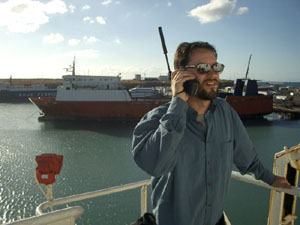
[Above: Expedition leader Nick takes care of an early morning satellite phone call (courtesy of our sponsor, Iridium) as the Sea of Cortez vehicle ferry nears mainland Mexico at Mazatlan.]
In a much needed "rest" day, the team drove off the Sea of Cortez ferry, and Ð on the advice of some surfers Ð drove to Cerritos Beach, north of Mazatlan, to put in some relaxation time. Some team members chose to use the time to get some Internet work done in the "Zona Dorada" tourist section of Mazatlan, while others took advantage of the sun and surf. Veteran surfer Neil caught some waves with Adam, then gave some afternoon surfing lessons to native flatlanders Justin and Rolf. The team spent the night on the beach in their Hannibal safari tents, lulled to sleep by the sound of the waves where the Sea of Cortez meets the Pacific Ocean.
| Logbook for November 18th | ||
| Start: Mazatlan, Mexico (ferry terminal) | Finish: Mazatlan, Mexico (Cerritos Beach) | Mileage: 27 |
November 19, 2003
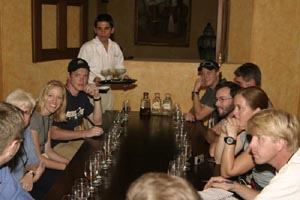
[Above: The team samples tequila in the basement of the Jose Cuervo distillery in Tequila, Mexico.]
"Are you kidding me?" I thought as Justin rattled the side of the car a little after 5:00am. We needed to rise early in order to hit the town of Tequila early enough for an educational visit/tour of a tequila farm and factory. We knew early morning call was coming, but that does not make the rude awakening any easier. We had our morning briefing and departed from the lovely beach and pleasant sound of the waves lapping upon the shore.
We made it through Matzalan and onto the toll roads without issue. Travel in mainland Mexico was quite different from traveling down the Baja Peninsula. First of there are many more trees and bushes, and much fewer towering cacti. The roads were good although you pay and arm and a leg to travel on them. The toll roads offer a luxurious four lane divided highway, clean bathrooms, roadside assistance and a respite from the sometimes crazy traffic.
The reason for our pre-dawn departure is we are behind schedule. We have a boat to catch in Panama in early December and there are many miles between here and there. Justin is currently figuring out what we are going to have to do in order to make our ferry to Ecuador. Unfortunately I think this means sacrificing some much needed rest days. To make matters for us today, we lose another hour as we drive east toward Mexico City.
While we drive through towns around the world one thing that is very interesting to me is the various statues I see. Public statues represent what cultures value. In the United States, military statues are the most common, in Mexico I have seen an overwhelming amount of statues dedicated to workers. I will continue to look at statues on our journey. Today most of the driving was an uphill climb. Tequila is situated at about 5,000ft above sea level. As we drove we snaked over and around the various hills and mountains. We saw fields of corn and we were finally excited to see the distinctive view of the blue agave fields. Tequila must be near!
Operating from just a Lonely Planet book we knew that there were tequila factories to tour, but we were not sure exactly where they were located inside the city. We headed to the Petron Distillery, whose front gates looked pretty regal for what I thought should be a factory. We asked them when the next tour was to take place, they said that the would resume in two days, since tomorrow will be a national holiday, the celebration of the revolution in 1910. However, they said that the Jose Cuervo factory, down the street, could possibly accommodate us. We headed down the street, hoping that things would work out. We strolled into Jose Cuervo at about 3:45pm and they said the next tour would be starting at 4:30pm. Perfect!
The tour began with a short promotional film describing how important the tequila industry was to Mexico. It was a real marketer's dream. After the film ended we got down to learning about the process of tequila making. Although, I have been calling this a factory it looked more like a what I would call a Spanish winery. The place had a regal quality to it -- plastered yellow walls with contrasting dark brown trim. It was quit clean and very orderly and it's hallways often opened up into landscaped or ornate patios. There were multiple open buildings that also reminded me of architecture found in the southwest of the United States.
As we walked through we saw where the "pineapples" (the agave hearts) were baked, cooled and juiced. We saw the large vats and modern equipment used to test the products contents and to insure its purity (for more information on the tequila making process please refer to the educational section about Tequila). We ended up in the family storage and tasting room. We had to go down a couple of flights of stairs into the rock-lined basement. I felt like we were in a "Pirates of the Caribbean movie" with all the barrels lined up around us. At this point all the tour participants were placed before three different glasses. This was a taste test to show the difference between the various ages of Tequila. The three samples we tried were silver, gold, and rested tequila. The difference between these is the aging process. The silver tequila is straight from the distillation process, the gold has been given oak barrel flavoring and the rested has spent a significant time in French Oak or American Oak barrels. The team had various favorites, but my favorite was the rested. Unfortunately it is the most expensive. After we tried the various tequilas they had us sample the Jose Cuervo margarita mix as a final marketing push. Everyone departed the factory in good spirits.
The team was excited about the prospect of staying at a hotel this evening, since we had been camping for the last three nights. The hardest thing about camping is the shower situation. Although it is possible to shower when camping, the experience is just not as easy as standing under a faucet of warm flowing water. The team was eager to wash hair and just do a good thorough once over.
The Cuervo people recommended a good hotel (with parking) and Neil's golden Spanish abilities got us a good price. People are often really impressed with the camera and thus are willing to wheel and deal. It was a great hotel, and I even managed to watch and episode of the Simpsons in Spanish.
We rallied for dinner and ate a delightful meal. However, it seems like everything is served with Tequila in this town. We made friends with the restaurant owners and the treated us to a refreshing lemon tequila drink.
After we began a search for a place where we could by a shot of Tequila. We felt that since we had driven all the way to Tequila we need to cap off the event. We found a place, however, we felt they wanted a bit too much for their product. We decided to go back to the hotel, where we sat around and chatted until our second "Take me with you" participant showed up.
Weariness over takes me -- adios from Tequila.
P.S. - First day with no rain.
| Logbook for November 19th | ||
|
Start: Mazatlan, Mexico (Cerritos Beach) |
Finish: Tequila, Mexico |
Mileage: 254 |
|
Elevation Differential: 5000 ft |
Weather conditions: Clear, high wispy clouds; cool to warm | |
November 20, 2003
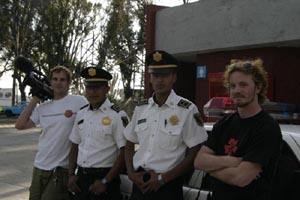
[Above: Filmmakers Adam and Colin pose with the Mexican police who provided us with an escort outside of Mexico City.]
Preface: AHA! My Spanish is improving, bit by bit. I took several semesters of Spanish in high school (Carroll High School, Southlake, Texas) and college (U.S. Naval Academy, Annapolis, Maryland), but I've forgotten most of it over the years. It is slowly creeping back to me. Sometimes, words and phrases will pop into my head, and I'll have no idea what they mean. Conveniently, my A-driver, Todd, is a master of languages and translates for me when I ask him the meaning of the latest Espanol to pop into my brain. "Todd, what does Ôentonces' mean, again ? (It means "well," or" then", and is used as a sort of connector) "And what the heck is Ôpor su puesto?'"(It means "of course", "certainly", or "for sure.") So, why am I telling you this? No reason, really, it's just on my mind. We're really immersed now, and we will be for the next few months. (ITALICS indicate undercurrents of thought within my wee brain.)
Thursday was an epic day for the LONGITUDE team. It started out routinely enough, but it eventually developed sufficient twists and turns, ups and downs, plots and climaxes for even the most scrutinizing adventure junky. It included Revolution, police escorts, breakdowns, lost roads, crooked cops, thieves, and adult television. Yep; it was sprinkled with a little bit of everything. Have I got your attention, yet? Good! (You have my permission to skip to the good parts...)
After a good night's sleep in Tequila, we left the hotel at around 0730 to head for Teotihuacan [tay-oh-tee-hwah-kahn], near Mexico City. (Teotihuacan is the site of some awesome, pre-Aztec pyramids. You can learn about it on our education page.) Joining our team as our second "Take Me With You!" guest was Christina, a native Guadalajaran and a friend of team member Neil. She is an awesome chick with superior language abilities and a pleasant disposition, and we were, and are, psyched to have her with us.
We were proud of our on-time start, but we got delayed a little bit by some photo opportunities in a blue agave field on the way out of town. This expedition is full of necessary delays, because we're trying to gather information and photos for you fine people...heehee.
November 20th is La Revolucion in Mexico, a national holiday marking the anniversary of the Mexican Revolution. The city of Tequila was all abuzz with celebration, and the significance of the day shown in the costumes, smiles, and decorations lining the streets. Little girls wore traditional dresses, and the boys were in white shirts and pants, red waist sashes, and huge sombreros. They carried toy rifles slung across their backs, and, to my great joy, even the tiniest boys sported big, Magic-Marker, Federale-style moustaches. The whole scene, from the dusty, cobblestone roads and flat-fronted plaster architecture, to the townspeople on horseback, looked like something out of a spaghetti western.
As we drove out of town on this cool, sunny, perfect Tequila morning, a parade of young adults carrying red and white balloons and wearing cheerleader uniforms and t-shirts of the same colors drifted by on the way to a celebration. It would have been fun to have joined them, but, like the traveler in the Robert Frost poem, "...I (we) have promises to keep, and miles to go before I (we) sleep, and miles to go before I (we) sleep."
Little did we know, the anticipated "miles to go before we sleep" for this day would turn out to be greatly underestimated...
The drive to Guadalajara was uneventful enough. Todd drove while I took a catnap. On the way through the city, Nick spotted a Land Rover dealership, and my vehicle and his did a U-ey toget some photos of our vehicles in front of it. The photos will accompany the press release I wrote for Land Rover Certified's marketing team. We often go out of our way during this expedition to grab good photos for our sponsors, and that, too, is a source of delay. It felt good to see the familiar green oval of the Land Rover logo. It's funny how the distance between the team and home can be made smaller by the similarities between home and here that we encounter along our route. A welcoming smile, shared laughter, or even a familiar green oval can make the world seem very small, indeed.
From Guadalajara, with Todd at the wheel so I could eat my salad, we continued southeast toward Teotihuacan. A hundred or so kilometers from the city, we passed by a huge lake off to our left (north). Our Lonely Planet guide book said it was Lago de Putzcwaro. Irrigation and other diversions feeding off of the lake will, at its current rate, cause the lake to be gone in 50 years, it said. It also said "You may notice the lake looks prettier from a distance than close up. Swimming in it is not recommended." About 40 kilometers prior to Putzcwaro was Mexico's largest lake, also rehearsing its disappearing act.
Just a few kilometers beyond the lake was a toll plaza (The toll roads are called "cuotas", and the free roads are "libres." Cuotas are way expensive, but they're about a zillion times faster and better than the libres, so we use Ôem whenever they're available.) with a pit stop for bathrooms and food. At most of these stops are little kids with squeegees who assault your windshield as soon as they can. I had a "conversation" with one of the little girls while waiting in line for a sandwich (torta). I asked her if she was hungry, and we ended up splitting one. She seemed pleased with the Hella (the awesome sponsor who provided us with rack lights for each vehicle and little keychain lights to had out) keychain light I handed her on our way out.
On the outskirts of Mexico City we came to a police checkpoint. There are A LOT of these police and military checkpoints sprinkled everywhere throughout Mexico, and most of them just wave us on through. This one did not wave us through, so the four vehicles pulled over to answer the question of "Where are you coming from, and where are you going?" "Tequila, and Teotihuacan," we answered. And the uniformed cop moved on to the next vehicle.
As the trail vehicle, we had no idea what was going on, but la Policia Estatal were out of sight talking to another vehicle, and it was taking too long. Eventually, we were informed that these guys wanted to escort us through Mexico City, or to Mexico City, or just through this neighborhood...we didn't really comprendo which. The reason, however, was that this was a sketchy stretch, and the policia, supposedly, were concerned about banditos hassling us and causing problems along the way. Personally, I am quite convinced that they just wanted to have some good fun, demonstrate their authority, and take advantage of an opportunity for some good training. Nothing wrong with that, right?
I really liked these guys. The very young lieutenant in charge reminded me of so many Marines I've worked with. He was sharp, neatly pressed, professional, helpful, and authoritative. His name was Omar, and he and his esposa were expecting their first child in a month. Omar and his men would ensure we remained safe.
With that said, please understand that I mean no disrespect with the perceptions I am about the lay out here.
From my rookie assessment, there was no real presence of danger, and we needed a police escort just about as badly as we needed a flat tire. I suppose, since we were neither hijacked nor ambushed, they succeeded in their mission. They also succeeded in slowing us down by AT LEAST two hours...AND they are responsible for the pitiful state we were to find ourselves in several hours later of driving around in circles through the skeeviest parts of the city...
They drove way under the speed limit, and cars were ripping around us at a really nice clip -- a clip at which we would have been happily traveling had these guys not felt it necessary to help and protect us. In addition to driving half the legal speed, they pulled the whole convoy over every 15 minutes or so at a new jurisdiction line to transfer the privilege of leading 4 cars full of gringos to the next set of cops and cars. Each exchange took roughly 10 minutes. There were about four of these.
At the turn-off for Mexico City, we were driving along and suddenly had to come to an abrupt halt to keep from smashing into the third vehicle of our convoy, who had stopped behind the second vehicle, who was stopped behind the first, who had stopped behind the police car that had suffered a catastrophic engine failure in the middle of the off-ramp on the other side of a blind curve. We were there, with our rear-end hanging out in highway traffic, for several minutes before everybody scrunched forward enough for us to move up a bit. I was furious -- nervous and furious. They finally got the car started again, and they continued on beyond the off-ramp just a hair. It was a hair shy of the amount of space required to safely pull the trail vehicle (mine) out of harm's way. I screamed at everybody to pull around IN FRONT of the cop car, since he's the guy with flashing lights and the ability to scare civilian drivers into not ramming into his rear bumper. It was done, and finally the guy got back in front of us and drove away. A few kilometers down the road, he was parked at an off-ramp, waving at us to continue along the highway toward Mexico City. We were finally free of La Policia Estatal. No hard feelings.
The only issue now was the fact that they had lead us INTO the city, and we had intended to go AROUND the city. Driving through it is hell. Take Washington D.C.'s beltway and L.A.'s 495, remove one lane, combine the havoc, make the lanes narrower, paint graffiti over all of the exit signs, and imagine trying to maneuver not one, but FOUR big cars through lane changes, and around reeling buses and construction zones. It doesn't work very well.
To make matters worse, we were receiving radio interference from some Mexican drivers using our same channel. Justin, in the lead and frustrated, came on to ask us to please keep the radio-chatter down so they can navigate in peace. "Justin, that was Spanish...I think we're sharing this channel," I said. A few minutes later, a male voice with a thick accent said something about "Land Rover Discoverys", and another said, "Pienso son gringos." Great, now they're talking specifically about us, and they're using derogatory terms. There went the last thread of my security blanket.
Because the signs indicating which exit leads to which road and city are all blotted out by gang tags, it's difficult to find the correct exit. It is so difficult, in fact, that we ended up driving around the city in a huge circle, through tiny barrios and mountain roads, for about six hours. (As a side note, we reached a peak altitude of about 10,300 feet in the hills around Mexico City, which itself has an altitude of around 6,000 feet.)
At around midnight, we stopped at the Walmart (the same one we had passed by several hours earlier, darn it) to regroup, eat, and use the bathroom. We got on the road again, and this time the correct one, and were eager to traipse on toward our objective, now a mere 30 clicks (kilometers) down the road. Ah, but before we could reach our destination, we'd have to cross several precarious intersections. At the spookiest intersection of them all, we were pulled over by some very suspicious-looking cops. They were NOT La Policia Estatal, but rather some rent-a-cop version. As Chanda noted, it looked like all three of them were sharing one uniform. One guy had the jacket, another had the pants, and the third had the boots. We have to be very leery of bandits posing as cops, so we were a little nervous. Christina, our Mexican friend, ensured us these were real police. I asked her if it is OK to ask them for some identification, and she ensured me that it was OK, that she had, and that they were the real deal. I wasn't convinced, because these guys just looked like such clowns.
Apparently, the reason they pulled us over was that we had failed to use our blinkers to change lanes. Whatever! I was driving, and I know for a fact that I and the vehicle in front of me had used our turn signals. How do I know? Because I had just commented on how important it is, when convoying, to signal your intent so that the vehicles behind you can keep the convoy in a tight formation. Oh, and get this: THE POLICE CAR WAS MISSING A HEADLIGHT!!!
The rent-a-cops, or parking lot attendants, or whatever they were, (El Transito Municipal) were demanding 1000 pesos per vehicle. You're kidding me! That's $100 bucks each, and transit cops shouldn't have the authority to write tickets, anyway. They said we could pay 1000 per vehicle, and we'd have to come back tomorrow to do it (yeah, right), or we could just give them 500 pesos per vehicle right now. Our Spanish speakers, Neil and Christina, negotiated for 30 minutes or so. They explained our cause: That we're driving through their beautiful country on our way toward a cure for Parkinson's disease. Neil told them, "People are dying throughout the world." It took some doing, but somehow, eventually, the guys let us off. WOW! I never would have believed it.
As we pulled back onto the street, the lead vehicle blew through a red light...wups...but I guess the coppers missed that one, thank God.
Eventually, we made it to the city of Teotihuacan. All we had to do was locate a hotel with secure parking. We did so in record time, and we were checked in and parked by 0253. The motel was gorgeous, each room had its own garage and hot tub, and there was free HBO and (of all things) adult television.
Our epic day was over, and the next one had already begun by the time we got to sleep around four in the morning. But the beds were comfortable, the vehicles were safe, and tomorrow we would see pyramids that were almost as old as the human race itself. Life is good.
| Logbook for November 20th | ||
|
Start: Tequila, Mexico |
Finish: Teotihuacan, Mexico |
Mileage: 463 |
November 21, 2003
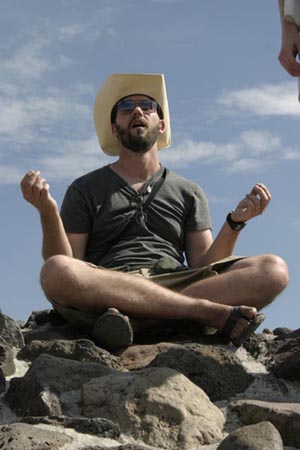
[Expedition leader Nick channels the Aztecs at the top of the Temple of the Sun at Teotihuacan, Mexico.]
Friday was a crazy day. We'd spent ALL of Thursday, I mean like 16 hours of it, driving from Tequila to Mexico City, where we promptly got horribly lost. Finally, at 3am, we pulled into an interesting motel in Teotihuacan, where in the morning we would see the famous pre-Aztec ruins. Morning came, and with the morn also came my good Mexican friend Rebekka, who I originally met in Tulum on my last Mexican Journey.
The pyramids were cool. Old, huge, and imposing, and stained with the blood of a million sacrifices (though the detail about the sacrifices could just be a legend). We spent a few leisurely hours wandering amongst them, enjoying all they had to offer, and we shot some good video footage for our program. When we were done, we all hopped back in the cars and Rebekka guided us through the madness that is Mexico City. There was only one small snag: We didn't know that if you had a license plate that ended in 9 or 0 it was illegal to drive in Mexico City on Fridays. This is all part of a program to cut down on urban traffic and pollution. So there we are, sitting on the side of the road while some of us ran into a computer store to pick up some doodads we needed, when who rocks up, but the fuzz, or the policia as they are called here.
The two cops initially told us we had to pay six hundred dollars and leave our cars with them over night. Of course there was no way that was going to happen so we started exploring other options. Neil started his "we're good guys, we're raising money for Parkinson's Disease" schpiel. At the same time, Rebekka was turning on the "I'm an innocent, beautiful girl, please don't do this to us" charm. Eventually, the officer said something along the lines of "Well, maybe you could help me out with a soda" -- which in laypersons terms means "Bribe me please". Apparently there are many different levels of bribery, and asking for a soda is the least. Asking for beer is the next step up, and your really in trouble if the cop says anything about helping pay for his kids college. So, this "soda" cost us ten dollars, and we were free to leave. After the fact, our other Mexican travel buddy Cristina informed us that the usual going rate for a "soda" is more like thirty dollars. This made a fair amount of sense because when Rebekka smoothly handed the policeman the hundred peso note he said, "Well, I could really use three sodas" She just said no, we don't have that money and we left the scene of the crime. So Rebekka facilitated our first bribe of the trip, and I'm glad she had he honor.
After the whole bribing thing was done, we headed on to Cuernavaca, where Rebekka had a condo-type place where we could all stay. Once again, there was a slight snag when our beastly vehicles could not fit through the gate, so we went through a little rigamorole finding some parking around the corner. Once situated, we hiked up the hill to Rebekka's place to relax. The original plan was for the whole crew to go out and party like rock stars in some swanky Mexican clubs, however, the exhaustion factor kicked in, and of the crew, only the three amigos, Adam, Neil and I, headed out for some fun. Of course Rebekka and Christina were with us.
We got to the club and we went through the usual waiting at the door until the guy you know comes out and says you're cool thing, and during that time I realized that I might as well test out my new persona "El Gringo Loco". The place was packed full of middle-class Mexicans, dancing their kulas off to an interesting blend of American and Latin pop. I hung out for a while and met some of Rebekka's friends and then wandered off for a while. I was repeatedly stopped and asked various questions in Spanish that, because of the insanely loud music, and my only OK Spanish, I completely didn't comprehend. So I just pretended to understand.
Mexican Girl: blah blah blahblah blah?
Colin: Si
MG: blahblah?
C: Si!
MG: Bla?
C: Si Bueno
At this point I would just shrug and say "Soy el gringo loco" which means, I'm the crazy white guy. After a couple of gringo locos the free drinks started rolling in. I spent the rest of the night dancing (not very well) with various Mexican chicas and having a blast.
It felt really good to get out of those cars for a while and do some socializing. Getting up the next morning at seven was a little rough, but I somehow managed. We all said goodbye to Rebekka -- and I felt bad for leaving her place such a wreck -- but the team was waiting so I couldn't stay around to help her clean. It was great to see her, hopefully next time we meet up we'll have a chance to hang out for a little while longer in a less hectic setting.
Rock on from Mexico,
-- El Gringo Loco
Colin@drivearoundtheworld.com
| Logbook for November 21st | ||
|
Start: Teotihuacan, Mexico |
Finish: Cuernavaca, Mexico |
Mileage: 98 |
November 22, 2003
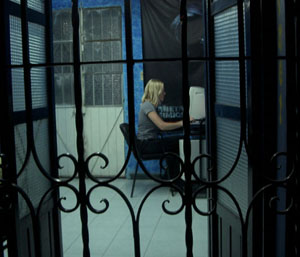
[Above: Chanda caps a day of driving with some Internet catchup in Oaxaca.]
Hello again, everyone. I hope you're enjoying reading about our LONGITUDE expedition. We have just completed the first three weeks, and are rapidly approaching the Guatamalan border. The last few days have been very busy, and they have taken their toll on the team. We could all use a chance to catch up on some sleep and laundry.
Today, our route takes us approximately 240 miles from Cuernevaca (just south of Mexico City) to the cultural center of Oaxaca, Mexico in the southeastern region of Mexico. As we descend further toward the equator, we've been fortunate to have some beautiful days for driving. Ample sunlight radiates in our cars as we continue counting down the miles toward Colon, Panama where we will catch a ferry to Ecuador. At the same time, everyone is still conscious of our friends and families back home, as well as the upcoming Thanksgiving holiday. So, on Thursday, if you have room, think of us and eat just a little extra turkey.
Before talking about today, I should mention that Cuernevaca, where we stayed last night, seemed like a really nice city. We were fortunate enough to stay as guests at the home of our third Take Me With You! guest. Several members of our team decided to soak up some of the local culture in Cuernevaca by attending a nightclub to dance with some local Oaxacans. The rest of the team decided to entertain themselves by creating a somewhat silly game with a tennis ball. As they played catch in the living room, they began charade-like antics where each person would reenact some projectile-type behavior to act as the catalyst for passing the ball to another team member. I sat outside in the cool night air and enjoyed watching the team and their antics.
We had an early call today (the time when someone goes around to wake everyone up -- usually me) at 6:30 so we could get started driving around 8:00 am today. Anytime we have a high-mileage day planned, we try to get an early start to allow enough daylight driving hours. One of the hardest things about the expedition are the times when we have to convoy around at night. On the whole, it taxes everyone's endurance more than normal daytime driving, plus there are numerous hazards that are on the road. It seems that all Mexican highways are full of "topes" or speed bumps. They tend to pop up out of nowhere, and there's absolutely no consistency to their size or frequency. There are other things to look out for as well -- pedestrians (even on freeways), bicyclists, dogs, cows, donkeys, and other drivers.
We loaded into the vehicles and made a quick stop at a convenience store to grab Bimbo donuts, muffins and some coffee for breakfast before heading for the highway to Oaxaca. Shortly after we left Cuernevaca, we were able to see the Volcan Popocatepetl, one of the highest points in Mexico. It would've made for a beautiful photo, but the morning sky was very hazy and made it difficult to fully take in the beauty of the mountain. From there, we continued onward with the Sierra Madre range flanking us on the right most of the way to Oaxaca. Along the way, we passed some very curious looking cacti. At the base, they looked like regular trees. However, they didn't have any arms. Each cactus pointed straight up into the sky with no arms. Very different than the cacti I'm used to seeing. They were so remarkable, we pulled off to the side of the road to take some photos by them and film the team chatting with a local hombre and his donkey. The donkey didn't have much to say, as I understand it.
After the photo session was completed, we continued into Oaxaca and arrived around 7:00 pm at our hotel. After checking in, the team was off to the Internet cafŽ to take care of business. A few people went their own way for dinner, myself included. I wandered down to the zocalo via the Alameda de Leon. Just past the majestic main cathedral, I found a hot dog vendor. Dinner was served. I treated myself to two bacon-wrapped dogs covered in chilies, tomatoes, and onions with a little bit of mustard, catsup, and mayo. Man, they were delicious. As I sat on a little park bench, I was able to soak up a little of Oaxaca as night took over. Dozens of street vendors were packing up their wares for another day, while on a bench to my right, a young Mexican couple sat kissing. The square was full of teenagers enjoying their Saturday night out while Tejano rock ballads played in the distance. The air was cool, but refreshing. It was a perfect Mexican night. It was exactly what I needed to unwind from the day and get ready for the next adventure.
I hope you all are well. Talk to you in a week.
| Logbook for November 22nd | ||
|
Start: Cuernavaca, Mexico |
Finish: Oaxaca, Mexico |
Mileage: 240 |
November 23, 2003
Today we drove, drove, drove and then drove some more to get from Oaxaca to Tapachula, Mexico's largest border town. The drive was a bit uneventful today, which is always a good thing, so I'm including some scenes from the road.
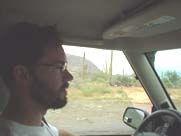
This is my husband and favorite car mate, Nick. He and I took turns driving to Tapachula. It was a long (15 hours!) and beautiful drive.
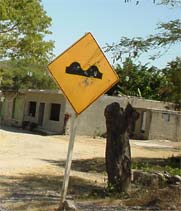
When you see this sign, slow down immediately or brace yourself for topes are coming. Like speed bumps, topes serve to slow traffic down through cities or residential areas. The two bumps on the sign really do not capture the magnitude of the topes. Topes are usually taller than they are wide, making the car shimmy and your teeth rattle, even at the slowest speed, as the car traverses each bump.
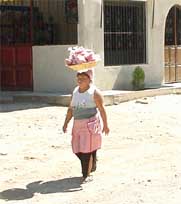
Some of the women have seen in Mexico can carry large baskets of food, laundry, and many other items on their heads.
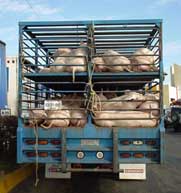
Pigs. Occasionally, we meet up with fellow travelers on the road. Oink.
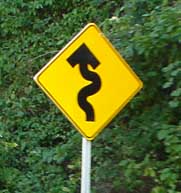
Another important road sign. This one indicates a winding road ahead. Much of the road we drove on today were mountainous and windy.
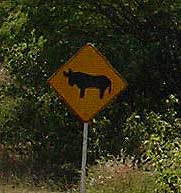
Livestock crossing. This road sign is important because much of the livestock in this part of Mexico roam free and occasionally make their way onto the roads. We had to stop twice for cow crossings.
That's all for now...
Peace out,
Chanda
chanda@drivearoundtheworld.com
| Logbook for November 23rd | ||
|
Start: Oaxaca, Mexico |
Finish: Tapachula, Mexico |
Mileage: 380 |
November 24, 2003
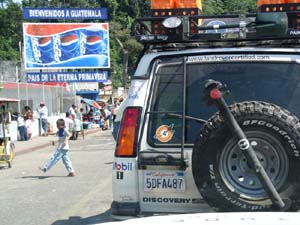
[Above: The DATW Land Rovers are lined up at the crossing-point into Guatemala from Mexico.]
So today we awoke in a small pink drive-in motel in Tapachula, about an hour away from the Mexico/Guatemala border. We all geared up and headed off to the airport to drop off Cristina, our new friend from Guadalajara, to head back home. She was with us for 5 days and we had a great time. She and I met a year and a half ago in San Francisco at a bar during the World Cup Games. I was teasing her since we, the USA, had just beat Mexico - but she later forgave me for my teasing and we became friends. Anyway, we dropped her off at Tapachula, and headed towards Talisman, the border town on the Mexico side of the border crossing into Guatemala.
And of course, we ran into the run-around. First, we passed by some the agricultural inspection and a bunch of kids jumped on our car and told us we needed to cancel our Mexico sticker, which we have on our vehicles. The stickers are our temporary permits to drive in Mexico. And we did need to cancel our permits, however trusting a bunch of children who are all yelling at you with instructions in the middle of nowhere an hour west of the border isn't the most comfortable situation. So we heeded their information that we needed to go to a bank called Banjercito to cancel our permits, but we pushed on closer to the border looking for a Banjercito. When we finally did find one, they told us the only place to cancel our permits was the one back at the agricultural inspection where all the kids had jumped on our car!
Oh well, we turned around and drove back and went across the street and cancelled our permits and received the appropriate documents to hand over to the border officials in Guatemala. While we were doing this, we bought some delicious empenadas with cheese and a spicy sauce, and some peeled pineapple, papaya, watermelon, and cantaloupe. The food in Mexico, especially when in the tropical south, is fantastic!
So onward we went until we finally arrived at the border. When we arrived there, there were two signs, one pointing towards the right, which was for cars without documentation, and the other was for cars with documents. We weren't exactly sure at first, then 15 or so kids jumped on our car as we were turning towards the right. I finally was able to tell them all to get off the car and just let one guy speak so I could understand what they were saying.
He told us to go back on the main road and head towards the border with him. If we went the other way, we would have to pay off officials and wait in a very long line. So we decided to listen to this guy, since the kids at the last passing earlier were correct as well.
Sure enough, this guy was our savior. He took us right into the border, and I grabbed all of our passports and we just went to a window with no line, got our exit stamps, then went to the other office, and got our entry stamps, and then to the copy machine to make copies of our documents for our vehicles. Each process cost us a few quetzals, which is the Guatemalan currency. And getting the quetzal was a funny experience.
The exchange rate was 7.9 quetzales to the dollar. When we told the guy we wanted to change $100, he would punch some numbers on his calculator, then show us the calculator and press 100 X 7.9 and it would come up as 690. And he kept doing it and I kept telling him, in Spanish, that this was nonsense. So I took his calculator and did it myself, and of course it came up 790. The silly guy would press -100 first, then show people the calculator and do the multiplication. I guess some people fall for it.
We then proceeded to the office where we needed to get our Guatemala car permits. Luckily, the letter we had from Mexico, which was notarized by a lawyer, worked here too. I assume it will work through the rest of Central and South America. So after a couple of hours of waiting for paperwork, we were through the border and into Guatemala. All in all, we paid about $60 for everything, not bad at all.
On to Guatemala!! Guatemala and Mexico are completely different from each other. We are in the intense tropics now and the people are definitely more of a Mayan descent. The people are very small as well. The children are so cute it is unbelievable. I love taking pictures, though it is known that some Guatemalans don't like their picture taken, so it is a fine line I was playing with, and filming them for our project is interesting as well.
The people here wear very colorful clothing. The women wear lovely dresses, filled with various color patterns, that cover most of their body and the men wear these striped wraps that are a cross between a sarong and pants, along with a Guatemalan shirt.
The people here walk around carrying fruit and supplies on their back with a blanket that is wrapped around their back. Many women carry baskets filled with bread or fruit on top of their head, balanced without the use of their hands.
Guatemala is extremely rich in culture and heritage. The people here are very traditional and preserve the way of life from their ancestry. Guatemala is also very poor. Driving towards Santiago de Atitlan, which is a huge crater lake amongst three volcanoes, we passed through many villages that were very poor. These villages have houses or shacks that are falling apart and barely standing. Guatemala is rich in culture, yet however, being very destitute, has been known to be dangerous as well. And driving through this country in our 4 new Land Rovers definitely turned everyone's head. We are a spectacle, there is no doubt about that.
And as we were driving towards Atitlan, we were approaching dark, and we still had an hour or so to go. We pulled over to the side of the road and had a very serious discussion about whether to head on or to stay where we were at. Some areas of Guatemala are known to be dangerous at night, and we had also all previously decided not to drive at night in Central American countries.
Early on in the trip we created a game of "firsts" - for example, who will be the first person to get sick, or the first to have diarrhea, or the first to get their foot run over by a Land Rover, etc. One of the categories was who would get angry and have a "meltdown" - and it looks like Rolf won. As we were having our meeting at the side of the road, Rolf got angry and said that the reason we were driving at night - the reason we didn't arrive at Atitlan hours ago -- was because we never leave on time in the morning, and we waste a lot of time at gas stations and food stops. Nick insisted that leaving on time is really not that important, and Rolf just lost it. Holy cow, I have seen movies where people go nuts and the look of rage comes to the surface, but in person, I haven't witnessed this pure anger in a long, long time. It was fantastic!! He was yelling, throwing dirt, and everything!! Everything eventually got worked out and Nick admitted that we've been sloppy about wasting time, but all Rolf's yelling was quite a spectacle! I'd say it was a healthy release and comedy for the rest of us, and something we can all tease Rolf about for the rest of his life.
So anyway, all us of voted to carry on to Atitlan at night. As we did, we drove on super windy roads up through small villages and into the beautiful volcanic mountains of Atitlan. We made it unscathed and drove through Santiago de Atitlan looking for a place to stay. This very traditional town was bustling, with a local soccer match going on in the town square on cement, and people all over the place walking around and enjoying this fine Monday evening. Guatemalans don't have much material wealth, but they do have an abundance of heritage and a zest for life.
I love being here and find it extremely interesting and full of authentic Guatemalan people. We have not seen many tourists at all. Guatemala is a place that people must experience in their lifetime. It does remind me of Peru and Bolivia in many ways. I highly recommend it.
Well, we ended up at a nice hotel on the lake, and half of us spent the night in our tents, and the other half in one big room. Tomorrow, we are heading to Antigua, which should be amazing. I wish we had more time to spend in each place we visit, but that is not the nature of our expedition. At least we get a taste, and can always come back another time. Until next Monday, ciao.
Best,
Neil (A surfer who has sacrificed surfing for a fantastic opportunity to see the world and help Parkinson's Disease. Yikes, I have only surfed one day in the last month!!! However, in two days we are going to La Libertad in El Salvador, and those of you who know, KNOW how great that place is for surfing!!!!)
| Logbook for November 24th | ||
|
Start: Tapachula, Mexico |
Finish: Santiago Atitlan, Guatemala |
Mileage: 175 |
November 25, 2003
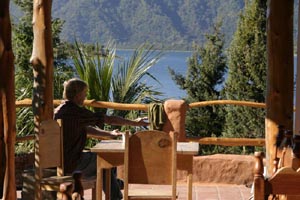
[Above: Todd relaxes on the peaceful shores of Lake Atitlan, Guatemala.]
I woke up this morning on the majestic volcanic shores of Lake Atitlan, put on a pair of jeans and a shirt, and stepped out onto the front porch of the hotel. I sat down on a wicker chair and looked out upon a wonderful tropical garden and a bright shining sun. I reflected upon the day before and the some of the traveling fears we experienced in order to get where we were today. Travel warnings have been issued for Guatemala and many of us have heard of stories that would curl your hair. As to how much truth there is to these stories no one really knows. It is just up to the traveler to use their best judgment when analyzing stories and information about any particular place.
In any case, the uneasiness was behind us and I sat drinking coffee in the sunlight. Early morning thirst motivated me to walk to the Land Rovers to get one of my bottles of water. On my way I met a Spanish fellow who greeted me and asked me where I was from. Only half awake at this point, I answered his questions and asked a few of my own. Soon we found ourselves drinking coffee on a balcony overlooking the Lago de Atitlan. It was a crystal blue lake flanked by volcanoes. These volcanoes had been extinct and evidence of this was the fact that their cones had been covered in a blanket of green flora.
Jose, the Spaniard (who I later found out was the owner of the Bambu Hotel in Santiago), answered my questions about Guatemala and allayed many of my fears of traveling here. He had traveled all over Latin America and finally settled in Guatemala about 12 years previous. During the course of conversations he mentioned that during the Reagan years American Travel to Latin America had drastically declined. He knew there had been travel warnings, but was not quite sure why they had been issued. This is something I will have to think about.
After awhile a couple from Northern Ireland came down to the lakeside balcony to have breakfast. We all talked together about where we were from and why we liked travel. It is so much fun meeting people and sharing perspectives on things. You can always learn interesting things when you listen to people.
As time went on the rest of the team showed up. It was so nice that we could have the morning to ourselves, not having to be anywhere. I was learning a lot in an incredibly beautiful place. It was like the day took my hand as I left my room and has been acting as my guide ever since. Everywhere I looked I saw something beautiful; everyone I met seemed to be interesting, and the coffee was wonderful as well!
Later, Miguel, a man who worked at the restaurant came and talked to us. He told us some history of the area. He spoke Tjutil (one of the native Mayan languages spoken in the region) to us, which has a fascinating sound to it.
As noon was approaching we were packing up to head to Antigua and an Australian couple came boating up to the dock. We became chatting with them and decided to have lunch with them in the town of Santiago. After lunch we parted, but continued to shop our way back to where we parked our vehicles. In the middle of a purchase Skye and Ben (the Australian couple) came running up and asked us if we could take them back to Antigua. We said we had plenty of room and they would be welcome to join us.
After making our way back to the vehicles we spent the remainder of the daylight hours weaving our way out of the hills and into the valley where Antigua is situated. We saw unbelievable scenery as we looked from the hilltops, switchbacks and up from the valleys. We saw livestock small farms, families walking in a row with hoes slung over their shoulders. The kids as well as the older folks work in order to put enough food on the table. It was an amazing drive.
These kinds of days are what traveling is all about. I had no idea what was in store for me when I woke up. However, by the time the day was through I had made a number of new friends, learned an incredible amount about Guatemala, improved my Spanish, and saw some incredible scenery.
When you are traveling your days will never be the same twice. You always have opportunities to meet new people, see new sites, and gather new perspectives. These are the trophy days of traveling and why I recommend traveling for everyone. I believe if everyone traveled and sought to understand and listen the world would be much more peaceful place.
| Logbook for November 25th | ||
|
Start: Santiago Atitlan, Guatemala |
Finish: Antigua, Guatemala |
Mileage: 75 |
November 26, 2003
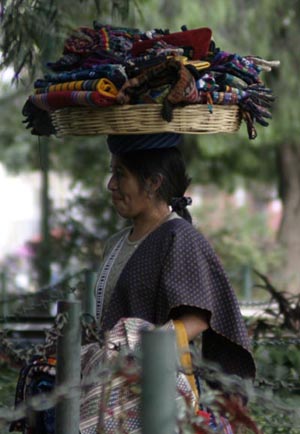
[Above: A woman sells Mayan wares in the central square of Antigua, Guatemala.]
Antigua, Guatemala is situated in the valley of several volcanoes, including Pacaya, Fuego, and Agua. Fuego still spouts smoke lava and ash, which is an amazing sight to see. Agua's claim to fame is that it wiped out the old city (the city in this city before Antigua was built), but not in the way you would expect a volcano to wipe out a city. It turns out that the caldron created within the top of the volcano was filled with water over time. After some heavy rains the caldron filled and spilled out upon the city below. The flood came with such force it completely wiped out the old village below. After this catastrophe, a new city was built near by and called Antigua.
This new Antigua soon became the capital of Spanish Central America. As you walk down the rocky cobblestone streets, you can see many of the ruined old cathedrals and buildings that have been shaken by violent earthquakes through the years. It is clear to see the effects of the earthquakes upon these buildings, but their dilapidated state bears a certain charm. The city blocks have narrow sidewalks with solid wall fronts on the buildings, most of which do not have windows facing the streets. When you look down a street it just looks like walls and narrow sidewalks line the streets. However the doors usually open into a large courtyard or a deep lot and the structures within these walls are very inviting.
Interestingly, Antigua owes is preservation to a historical string of bad luck. After a major earthquake, it was decided the capital was going to be moved to where it stands today, Guatemala City (northeast of Antigua). Following the move, an economic depression occurred. This dissuaded people from investing in the city, and thus the old structures were not torn down and replaced with new ones.
This city is amazingly beautiful, though it seems to be becoming quite crowded and the Burger Kings, American discos, and omnipresent Internet cafés challenge the once-used description of "quaint". This a bastion of Spanish language schools, and in one sense you couldn't find a better place to study Spanish -- but on the other hand the environment of Spanish-only speaking people is not what it used to be.
It seems as though a lot of changes have occurred since I first visited this place in 1997. Back then the streets were less crowded and you would have had to hunt for an Internet café rather then just fall in a certain direction to be in one. The addition of a Burger King was probably the most surprising addition to the city (although the façade of burger king was cloaked with the traditional architecture).
Who knows where the changes will lead. New revenues often lead to new possibilities as well as new problems. It will be interesting to see what will remain important to the People of Antigua as their city goes through these changes.
I still think the city is quite beautiful and there is still much to be explored and much I would like to do in this city. I will definitely return to Guatemala and Antigua in the future.
Although this city has many amazing sites I stayed back at the hotel for much of the day. It was truly wonderful to lie in bed and read about the places where we were going and some of the places we had been. The break neck speed in which we had been traveling, which now had been lifted, took the weight off our shoulders and made it possible to relax. We didn't have to pack and load up the cars, we didn't have a morning briefing; we were left to ourselves and that was just what we needed. Although each and every one of us has writing and other jobs to do, we now had time away from our jobs, companions, and the vehicles. I spent time working on the educational aspects of the trip and how to encourage more students to use the sights.
I was gathering information about El Salvador and Honduras as a rainstorm passed over our heads. I loved the storm as I had a roof over my head and a blanket over my feet.
This is Todd signing off.
| Logbook for November 26th | ||
|
Start: Antigua, Guatemala |
Finish: Antigua, Guatemala |
Mileage: Rest day |
|
Weather conditions: Sunny and warm, slightly humid, with afternoon rain | ||
|
Breakfast: : Chiliquiles |
Dinner: Rice, beans meat and soup |
|
November 27, 2003
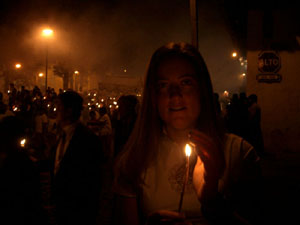
[Above: Nancy joins a candlelight procession on Thanksgiving night in Antigua, Gutamela.]
I learned a new phrase today: "Me faltan dos de mis pantalones."
This morning, I awoke at 0700 to the sound of rambling buses and conversing roommates in a four-bed, summer-camp-style room on the third floor of "La Casa San Lucia" in Antigua, Guatemala.
Apparently, I woke up on the wrong side of the bed. I was going to go back to sleep in order to try for the other side of the bed an hour or so later, but suddenly a harrowing thought occurred to me: "I don't think the laundry gave me back all of my pants!"
I couldn't lie there and sleep with such awful thoughts resounding in my brain, so I sprung into action and had a peek inside my duffel. Oh, fercryingoutloud! My two favorite pairs of pants were, indeed, MISSING! Now I would have to figure out how to ask the ladies at the laundry if they still have them.
You see, a few of us dropped our laundry off to be cleaned at a lavenderia yesterday morning, and we were told we could retrieve our things at 5:30 that night. When it came time to pick up our clothes, I was busy doing something else, and Todd said he'd grab them for me. Well, the bag seemed light when he handed it to me, but I didn't really give it much thought until this morning. That's when I felt an emptiness where my blue and my red pants used to be…
My fellow explorers were eager to help. Rolf pulled out his Lonely Planet Phrasebook and found something for "I am missing one of my _____." (Me falta uno de me ______.) "OK, that'll work," I thought. "I'll just fill in "two" and "pantalones."
I got all worked up and ran down the block to la lavenderia with Todd, certain that some lucky customer had arrived home with MY awesome pants. I needn't have worried. You see, on this Thanksgiving Day in Guatemala, I had even more to be thankful for than I was aware. My pants had, indeed, been placed in another customer's bag, but that customer had not yet returned to pick up his or her clothing. I had stared Defeat in the eye, and I had won! Halleluiah, I had my pants back.
We returned from the laundry adventure at about 0900, and Todd and Rolf left to go visit a farm with the film crew. I had big plans to catch up on my writing, but something emanating from my computer, perhaps it was the soft glow of the screen or the low, monotone hum of the hard drive, put me right to sleep. When I woke up again, it was 4 p.m. Luckily, this time, I had gotten up on the right side of the bed!
We had placed Thanksgiving dinner reservations for 7 p.m. at a local restaurant, so I had a little bit of time to kill. The film crew wanted to film Rolf getting his hair cut, and I decided it'd be great fun to go along. I was psyched because he was going to get it buzzed super-short. The Marine in me has been pining for the company of some of my peeps, so having a "short-hair" around, I thought, would make me feel more at home. Rolf has very angular features, and I was convinced the "Rolf Lundgren" look would suit him.
We walked a few blocks to a local indoor/outdoor market to look for some prize items and do a little filming before inquiring about a barber. This was where I found a cool Gallo (the local brew) t-shirt (camiseta) for $3 and a nice oriental-style blouse for less than $6 just yesterday.
This market was Amazing with a capital A!!! On the outside, it was rows and rows of little booths. You could get shoes, shirts, belts, hammocks, bootleg CDs and DVDs, toilet paper, sunglasses, fruits and veggies, and whatever else your little heart desires. Rolf and I shared purchases of fruit and sweets, and we headed out to ask about a barber. A local gentleman indicated we could find one just on the other side of the buses and up the street on the right. (The buses are old American school buses painted up like a box of Crayolas. A select few are au naturale with the original school and county names still visible.)
We found the barber, an authentic place full of locals and good vibes. Rolf and I hypothesized that a lot of town gossip probably transfers hands within its walls. The little place was humming, and it wasn't just the sound of the Number 2 clippers I'd requested for Rolf's head. A television was on in the corner, men were laughing and swapping stories, and barbers and patrons were commenting on the latest headlines. We, on the other hand, were giggling at the point-and-choose posters displaying drawings of the different hairstyles available. Apparently, '80s styles are still in fashion in Guatemala, and we wished Rolf's hair were long enough for the Musico (a curly sort of mullet), the Serpentina (brushed back with wings), or even the Normal (a classic Beatles-looking bowl cut). Rolf got his buzz, I got my faux-Marine fix, and the film crew got some rich footage.
From there, we went downtown to see the women washing clothes in the square, and we also caught a glimpse of a church service that involved blue and white streamers and intermissions during which one of the guys would run outside into the street, launch a few mortars (giant fireworks), and run back in. We never did figure out what the occasion was, but the explosions could be heard throughout the duration of our stay in Guatemala.
At 7 pm, we all met at a restaurant called "Las Palmas" for their "Famous Thanksgiving Dinner." (You can walk everywhere in Antigua, so that's how we got around.). We toasted Nick and Chanda for the hard work they do to make this expedition possible, and we gave thanks for our new friends from Australia joining us at the table (Skye and Ben - two super-cool travelers we met two days ago in Santiago de Atitlan) and for each other.
The dinner was OK, but it wasn't Mom's. The good thing is, there were no fourths, thirds, or even seconds, and the pumpkin pie wasn't good enough to eat, so I don't think I gained any weight this Thanksgiving! It wasn't the best dinner I'd ever had, but the turkey wasn't dry, so we were happy. It was odd having that all-American family meal so many miles away from our families.
It didn't take us long to wolf through the dinner, so we had a lot of time for conversation and staring at candles. Whenever there are candles at the table, Adam and I tend to play with the wax, and this was no exception. I decided to make one of my own out of a napkin and melted wax, and, by the time we left, I had a pretty good one.
Remarkably, we walked only two blocks away from the restaurant before happening upon a procession of local worshippers carrying CANDLES!!! We had heard fireworks going off, and had run excitedly toward the explosions and what we thought must be a wedding. All giggles, we screeched to a halt when we saw the somber faces illuminated by the flickering flames they carried. A little boy lit mine for me, and we stood there wondering what the occasion marked. (Do any of you Catholics know what is special about Nov. 27?) Fireworks exploded over the heads of onlookers and worshippers until the procession made it through the cathedral doors and out of sight. Minutes later, we, too, were out of sight down a dark side street.
We bid farewell to Skye and Ben at their hotel and walked the block back to our rooms at the San Lucia. Tomorrow would be an early morning departure and a border crossing into El Salvador! With a little luck, well spend tomorrow on a sun-soaked beach!
That about sums up our Thanksgiving. We're most thankful for you blog readers; we're glad you're out there. And I am personally thankful for my friends and family (hi Mom, Dad, Eric, and Stace). I won't name names, but here's a shout out to my best friends in D.C., SoCal, Maryland, Texas, Mass., the Republic of Georgia, the Pentagon, and the Big Sandbox. You know who you are. Boy, I sure do miss you all. See you in eight months…
| Logbook for November 27th | ||
|
Start: Antigua, Guatemala |
Finish: Antigua, Guatemala |
Mileage: Rest Day |
November 28, 2003
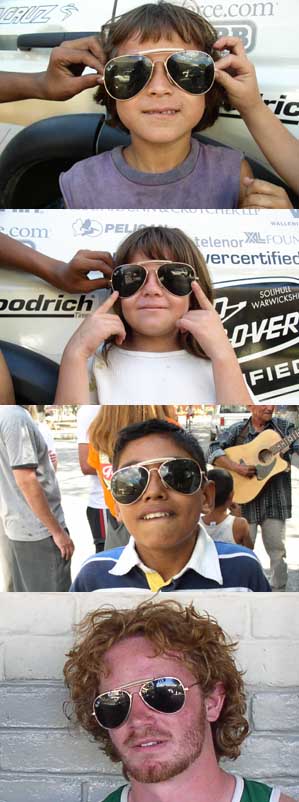
[Above: Who is the real Colin "Corndog"?]
We left the tourist city of Antigua, surrounded by beautiful imposing volcanoes, watching the volcano known as Vulcan de Fuego erupt plumes of smoke. The majesty of that sleeping giant was impressive. Unfortunately we ended up watching this wondrous sight from the location of our breakfast break: the parking lot of a Guatemala McDonald's that had hedges cut into the shape of the trademarked "M". Strange feeling, but as my 2 Egg McMuffins disappeared into the depths of my stomach, so did my qualms concerning ingesting American fast food in a developing nation.
The day had started out early at 6am, the time we've set for days when we are planning to cross borders. On this day, we were planning to cross from Guatemala to El Salvador. We arrived at the border around 10am -- nice and early, and eager to move on. As usual though, the moving on part was the hardest. Personally, I've learned that one word rings truest at borders -- and that word is "patience." There is tons of red tape and bureaucracy that takes place on the frontier between nations, and the only way to make your way through it is to kick back and enjoy the sketchy scenery that surrounds. I like to use the time to sit around to work on my Spanish, and who better to learn from than children.
Children in border towns often live sad lives: They spend the majority of their time panhandling or selling low-cost goods, mostly beverages, to the people in transit. On this particular day my most meaningful encounters were with two children in particular, Dennis and Mila.
I met Dennis as soon as I exited my car. He came up and asked if I needed any help (in Spanish) and I asked him if he could take me to a store where I could but some stuff I needed. Of course he could help, and off we went in search of a local tienda, at which I could buy what I needed. On the way, he asked my name, and when I told him, he couldn't really pronounce it -- so I defaulted to "El Gringo Loco", which immediately put a huge smile on his face. The store was found, and I used my change from my purchase to buy my newfound friend Dennis (third photo from the top) some candy. After that, Dennis was my best friend for an hour or two. We hung out and talked for a while. I used the Spanish I have to find out a little more about my new amigo. He was 13, had two brothers, had no girlfriend (although there was one girl he liked), he also liked soccer, and went to school, which he surprisingly said he enjoyed. Apparently, I had met him on the month of his summer vacation, and that was why he wasn't in school. I asked which he liked better, school or vacation -- and as I figured, he preferred vacation.
Anyway, after some time spent in friendly conversation, Dennis's friends came around, introductions were made all around, and when the others struggled with my name, Dennis informed the bunch that I was formally know as El Gringo Loco. Within minutes I had a bunch of little El Salvadoran kids yelling "El Gringo Loco" in unison, and just generally having a good time. They were an agreeable bunch of guys, so I bought them and myself an ice cream cone (the grand total for nine ice creams was one dollar). Now I had a little posse all my own. They followed me everywhere for a while, and I was having fun working on my Spanish and just horsing around. I taught them my "monkey dance" and Todd and Adam played some guitar so we could try and teach them some Beatles songs. I asked them all the standard "getting to know you" questions in Spanish and they all responded nicely: they all went to school and were enjoying their month off, and only one of them had a girlfriend, and her name was Roxanne (I tried to teach him the Police song of the same name, to no avail).
Eventually the guys started hounding me to give them stuff and I had to sit them all down and tell them all that begging for money wasn't going to work, and that having fun in life was more important than money. That worked for a little while, but my fellow redhead Nancy decided to hand out some give-aways to some of the kids, and that started the begging all over again. At that point I kind of just wandered off and sat down on the curb.
So there I was, relaxing and trying to get away from the fray of children, when a little angel with a basket of beverages on her head walks up and sits down beside me. She asked me to take a picture of her and I was more than glad to. She told me her name was Mila, and we had a nice conversation about what her siblings' names were, and if she went to school. She was definitely the most agreeable and cute out of all her peers at the border, and the whole crew took a liking to her. I spent a nice hour with her having simple discussions in Spanish and teaching her a little English here and there. We took some more photos with her sister for my "Cult of the Corndog" collection (see above), and she enjoyed seeing the images on my digital camera. Adam and I broke out our video camera and shot some interesting footage for our show, and then it was time to roll on to El Salvador.
When I first arrive at a border, I always have fun. The children are fun, cute, agreeable, and for me easy to understand and talk to. Eventually though, I always grow disheartened. It saddens me that these kids are out there begging for money for food. They always tell me they are hungry, and I usually believe them. I'll never know if it's true or not, because there is always the possibility that they just have nothing better to do, but for now, ill just assume that I am helping these kids out.
Colin
colin@drivearoundtheworld.com
P.S.- Team entered El Salvador. Crossing took 5 hours.
| Logbook for November 28th | ||
|
Start: Antigua, Guatemala N: 14* 33.606' W: 90* 44.252' |
Finish: El Tunco, El Salvador N:13* 28.978' W: 89* 19.955 |
Mileage: 135 |
November 29, 2003
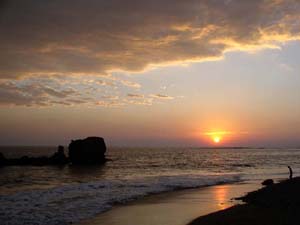
[Above: A gorgeous sunset at El Sunzal beach, near La Libertad, El Salvador.]
Hello everyone,
The last few days have been really enjoyable. Everyone has been really curious about seeing El Salvador, especially since we're all familiar with how the country was affected by war in recent years. We had a beautiful morning drive yesterday through a lush, green valley full of corn, milo, and other crops. The valley was flanked on two sides by volcanoes, and we were lucky to see Volcan Fuego belch a puff of smoke into the air. I tried to get a picture, but it didn't really turn out. But just imagine a full 180-degree view with the morning sun peaking over the volcanoes as one of them erupts, almost as if on cue.
Crossing the border into El Salvador, we encountered groups of locals, all curious about who we were and what we were doing. It appears that the American tourism market in El Salvador is still behind other Central American countries. It is a shame, too, because El Salvador is the prettiest country we've visited so far. As we traveled from Antigua to El Sunzul, we dropped aver 5,000 feet in altitude and the temperature jumped from 75 degrees to just over 100 degrees. This is important because in order to improve our fuel economy, we're not using the air conditioners except for really hot days. And we haven't hit them yet. Those will come in Australia and India.
The border crossing took us 5 hours. A little longer than expected, but there's not much you can do. Border crossings are full of paperwork and lines. They're never really that busy, but they're never in a hurry to get you through, either. We met some young girls working at the border selling water and sodas. These girls, like so many others in Central America walk around with large bowls on their heads filled to the brim with whatever they are selling. And they have done it for so long, that the items remain perfectly balanced whether they are walking up or down stairs, hills, or avoiding objects in the street. I should mention that these girls were 6 and 9 years old. It truly is a different way of life here in Central America.
As we approached El Sunzul (about 20 kilometers west of La Libertad if you're following along at home), the terrain became very tropical. Palm-trees and other coastal vegetation began to appear, and remarkably the roads in El Salvador are great. In fact, they are much better than many of the highways in California. They are only 2-lane roads, but they are very well kept. We wound up missing the turn off to El Sunzul, but we found a small bungalow hotel called Roca Sunzal on the beach just east of our target destination.
We spent a lot of today getting to know several of the local residents. Our host was a native El Salvadorian named Oscar, and he is a Los Angeles neon-sign-maker who now splits his time between the US and El Salvador. He was smuggled into the US when he was 14 by his mother. Once there, he began learning the trade and after dealing with some unscrupulous bosses, he eventually started his own business and became successful. He has returned in recent years to invest some of his earnings into the local El Salvadorian community.
I spent a good portion of this day with Luis, one of the workers at the hotel. He helped guide me into town to run some errands. On the way we visited about our families. He is married, but separated. This seems to be a taboo subject in El Salvador. But he has a son who is 17 and plays football (soccer) and a 9-year old daughter. He used to live in Los Angeles as an illegal alien to make money to help pay to raise his children. As a truck driver in the US, he made about five dollars an hour. In El Salvador, he makes five dollars a day. He was eventually deported, but is glad to be back in his native homeland.
I spent the afternoon learning to surf, and I had a chance to visit with local kids who surf every day. My wipeouts are the best -- so I heard. I am so beaten up, it's not funny, but I did catch about 6 waves. The effort was very worth it. Our day ended with a typical El Salvador dinner -- rice and carne (meat). We watched the sun go down on another day and went to bed early. Tomorrow is another full day of driving, plus we're crossing the border into Honduras. I hope you all are well.
Until next time,
Justin
justin@drivearoundtheworld.com
|
Logbook for November 29th |
||
|
Start: El Tunco, El Salvador |
Finish: El Tunco, El Salvador | Mileage: Rest Day |
November 30, 2003
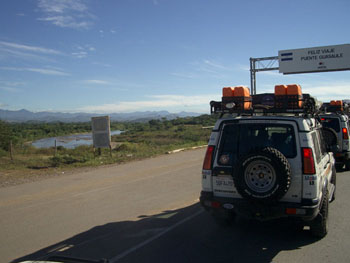
[Above: Drive Around the World Land Rovers roll across the El Salvador border into Honduras.]
Team entered Honduras. Crossing took 4.5 hours.
| Logbook for November 30th | ||
|
Start: El Tunco, El Salvador |
Finish: Choluteca, Honduras N: 13* 18.761' W: 87* 11.415' |
Mileage: 195 |
December 1, 2003
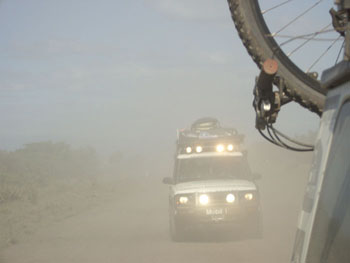
[Above: The roads into Nicaragua from Honduras were rough and dusty. It made for a fun drive!]
You gotta watch out for the police in these countries. They are tricky and will try anything to swindle a buck from you. Especially at the borders!!
Today, we all awoke in Choluteca, Honduras in a small hotel. There isn't any hot water here in the showers, and you wouldn't want to use it if there was. It is usually about 90 degrees or so in the day, plus humidity, and stays hot into the night. So a nice cool shower is a blessing.
We got in our Land Rovers and headed out of town. On the way out of town, there was a policeman who waved at us and yelled that we were going the wrong way on a one-way street. He came towards us to pull us over, but we just smiled, waved, and drove on like everything was normal, since we didn't want to risk another bribe situation.
We proceeded to drive through the beautiful Honduran countryside to the border. We really didn't get to stop in Honduras at all, just passed through most of it last night, and headed towards the border early in the morning to get to Nicaragua so we have some time to spend in Granada.
The last two days were my favorite days of course, we surfed in El Salvador and that was amazing! That is someone else's day to write about though.
So we approached the border and the fun began. First off, a cop stops us and asks for our licenses. Well, let's see here. Yesterday, when we gave the cop our licenses, he wouldn't give us our licenses back until we paid him. So this time, I showed him my license in my wallet and he tried to take it, and I said no, and just held it and showed it to him. He persisted and then I told him, "look buddy, the last cop I gave my license to tried to rip us off and I am not playing this game of yours, so look at my license with you eyes because your hands aren't touching it!" He looked at me with a bewildered look, and accepted my proposal. He then asked us if we had a fire extinguisher, trying to play the other angle, but we had a fire extinguisher, and he let us go forward.
So at these borders, since I am pretty fluent in Spanish, I am the official border negotiator, I do all the talking and paperwork and deal with the 3-6 hour process of swindling, mass copy making, and trying not to get ourselves ripped off too bad.
So today at the border crossing into Nicaragua, it actually went really smooth. I picked a guy to help us cross the border and he was honest: brought me to the right doors, expedited the process by eliminating some lines, and we actually paid the official costs (which is imprinted on the receipts) for our vehicles. It was legit and only took three hours. He did try to charge us six dollars for 32 copies though, which was ridiculous, but we talked him down.
At these borders, you really need to see the children. They are spending their entire days begging for money, or trying to clean your shoes for money, or sell you something. They are only little children, and have no education. It is really sad, and makes you realize how fortunate those are who have an education and the opportunity for much more than a life in a border town. One child was just staring at our food while we were eating -- he didn't ask for money, he just wanted food. He was dirty, malnourished, and looked tired, so I gave him the beef off my plate. Poor kid.
So now we pushed on through Nicaragua. Nicaragua is a great country. The roads are half unpaved, and the other half that is paved, is filled with potholes. It reminds me of the outback roads I used to drive when I lived in Costa Rica many years back. Because of the heat and dryness, there is dust flying everywhere. The people who live by the roadside have their houses and all their belongings filled with dust all day and night long.
The landscape is breathtaking, volcanoes almost everywhere you look, fields of sugarcane, rolling hills, rivers, and all kinds of tropical trees and plants. One thing I noticed also was many of the fields are not farmed or used at all, and I assume it is due to the massive hurricane (Hurricane Mitch) that wiped out Nicaragua and Honduras in 1998. I was in Costa Rica at the time and remember seeing the towns completely flooded and destroyed. What a disaster -- and to drive through this country a few years later, it's hard to imagine what it was like during those times.
Well, we pushed on through Managua, the capital, and got a tad bit lost, and then found our way south towards Granada! We arrived in Granada at sunset and it was such a sight. Granada is one of the oldest colonial cities in Latin America, founded in 1524. And unlike Antigua, which was completely devastated by the earthquake in 1773, Granada still has much of its colonial architecture in place.
So we then headed to the local pizza joint and delved into a North American (Italian) delight. Every once in a while, we have to stray away from the local foods and eat something from home, and mmmn, that was good pizza. On the way to the pizza joint, Rolf, wearing an M-80 on his ear, and Collin and Adam with a few in their pockets, started lighting fireworks and throwing them in the streets and having a blast! Kids all over these towns are lighting fireworks nonstop.
It is also the beginning of the holiday season, so there are a lot of festivities going on, for instance, after our pizza last night, we ended up in a bar upstairs overlooking the central streets of Granada, which was filled with Nicaraguans celebrating the "Procession of the Virgin." There were hundreds of people walking in the streets lighting fireworks, walking, talking, yelling, and proceeding down the street. At the tail end of all the people filing down the street, was a float with a young girl, I think Miss Granada, and a band playing the procession music. After they passed, within 10 minutes, that street corner was quiet. This procession goes on for 9 days, so I will let tomorrow's writer fill in on this.
Take care you readers, and know that we are heading to Costa Rica in a few days and once again, we will be surfing!
Neil
neil@drivearoundtheworld.com
P.S. - Team entered Nicaragua. Crossing took 4 hours.
| Logbook for December 1st | ||
|
Start: Choluteca, Honduras |
Finish: Granada, Nicaragua N: 11* 55.802' W: 85* 57.003' |
Mileage: 173 |
December 02, 2003
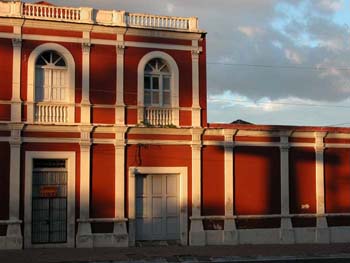
[Above: Classic colonial architecture near the central square of Granada, Nicaragua.]
Since we've been traveling so fast, I've had little time to sit and think about what to write. The car could be good but I usually sit in the front seat with the camera ready to shoot whatever happens, or I am driving and telling Colin to shoot because he is either sleeping, playing DJ, talking incessantly or sleeping. Neil prefers the back and seems to sleep or play himself to sleep with the guitar, snap a few shots out the window and then sleep again.
Our car hasn't taken on as much character as the others. We have a Virgin Mary cardboard air-freshener spinning aimlessly from the rearview mirror. We are hoping that perhaps throngs of shotgun wielding banditos will offer us three more respect should they decide to attack the convoy since we appear to be on the same side as the Virgin Mary. A little carlita is attached to our dashboard. Neil picked it up at a gas station in Vegas, and border kids seem to love it. Its one of those little Chevron cars that has eyes for lights and a mouth for a grill. They cling to the car for hours peering at it through the window and sometimes try to snap it up. They try whining, begging, big eyes, pouts, and some put their head so close to it you'd think they were going to bond molecularly with it.
At the I'm sitting in the lobby/cafe of our motel in Granada, Nicaragua. I woke up this morning to fans whose blades swilled the humid air over four sweaty bodies. No windows in the room, and a single small bulb burned above in the middle of our room.
Overall I've been doing fairly well. Only one bout of traveler's diarrhea since we left a month ago, and I've been eating at all the street vendors along the way. Cheap but occasionally risky -- it makes for an exciting meal. The meal discussions usually revolve around how intense the consequences will be the following day, and culminate in a philanthropic donation to a local perro with the hopes that he or she will sleep with of a full belly at least once this month. Yesterday I wondered whether the flea-infested gaunt canine could be resuscitated to the point of becoming a confident alpha male in the village. They seem to slide into a state of despair where the lack of food and nutrition deteriorates their coat, fleas infest them and they chew themselves till it bleeds. Flies then move in and infect the sores. Half their energy is then spent fending themselves from flocks of buzzing pests while the other four-leggers have time to beg for food and make puppies. Their confidence and pride is lost in their eyes and despite their appearance, they revert back to the puppy expressions throughout every bite of your meal.
Today will be spent in the ghostlike town of Granada. It seems to sleep during the midday and grow more and more vibrant as the sun goes down. Colonial but decrepit, there's character here. I walked with Colin down to the lake the other day. Its massive -- bigger than Lake Tahoe if you've ever seen that. Hot onshore winds blew across the murky brown water leaving countless whitecaps and wavelets. Immediately it reminded me of the San Francisco Bay if it was located somewhere warm and was never protected by environmental agencies. We brooded down the strip. Empty and quiet other than the odd stray and four boys practicing their kickboxing moves near the weed-covered beach. Bamboo, Cesar's, and salsa bars all lined the coast empty and in what seemed like a theme of disarray and decadence. You get this a lot in tropical climates. The trees and weeds and plants grow so fast that man seems to struggle keeping it back. It makes me wonder if places like Machu Picchu and other ruins were deserted by man for some mysterious reason or just attacked by such aggressively growing plantlike that it swallowed them whole.
Tonight is the "Procession of the Virgin" here in Granada. It's an eight-day ceremony where a mini parade flaunts a young girl and a statue of Mary through the center of town. Last night was rather interesting. First the bombas were exploded by professional pyrotechnics called "ninos", as they run ahead of the crowd tossing what look like sticks of dynamite and small mortars into the air. Next came some form of transportation that carries the Virgin. Yesterday a Willy's Jeep was pulling the young lady who was standing expressionless on a trailer next to a Cardboard castle tower. Behind her was the classic "oom-pah", Latin 5 piece band with white horns and a slacked style. It all happened so fast, and then the street seemed to clear until soon it was almost empty. It rained hard and then we made our way back home by 10pm.
Adam
adam@drivearoundtheworld.com
| Logbook for December 2nd | ||
| Start: Granada, Nicaragua | Finish: Granada, Nicaragua | Mileage: Rest Day |
December 03, 2003
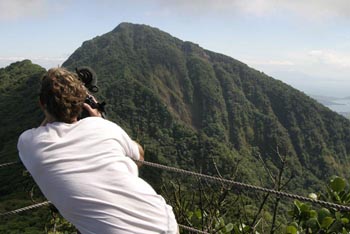
[Above: Video producer Adam shoots footage from the peak of the Mombacho Volcano. Click here for a pop-up photo of the fireworks crowd at the Virgin festival.]
It was another day in Granada -- firecrackers (bombas) popping and a mobile altar blaring (a car with a loud PA system driving up and down the streets, blaring religious messages, or which I couldn't really understand at the hour) before the sun even came up. I don't know if this happens every morning, or just around Christmas time.
Signs of Christmas were everywhere, lights, Christmas trees and Christmas carols in Spanish playing from radios. Apparently this city possesses greater admiration for Mother Mary than any other place on Earth, according to the Pope. We will get to this later on in the evening.
Granada is an interesting place. In the town square I saw a plaque stating that this was a sister city to Antigua, which I did not find surprising. The both have a similar feel, although Granada is much more spread out than Antigua. Both possess early Spanish architecture and oddly enough, both are shadowed by volcanoes that have altered the lowland history by flooding and ruining the cities below.
Anyway, we woke up this morning with a mission to ascend to the top of the Mombacho Volcano, which is situated on the outskirts of the town. Around the peak of Mombacho is a cloud forest; this condition is caused by the high elevation, high winds, and the tropical climate. You can hang out in the clouds.
The team was up early eating traditional Nicaraguan breakfasts of eggs, rice and beans. We needed to bring a lot of water, sunscreen and rain gear, because our guides promised us that things would be wet. Because the climb to the top of the volcano is so steep we needed to bring the Land Rovers; other non-four wheel drive vehicles would not be strong enough to make it.
As we headed outside of the city to climb the mountains we saw, horse carts, chickens, and people of all ages, walking to work with their machetes (the most useful tool ever). There were gardens filled with bananas and mango trees and all kinds of vegetables. The houses that surrounded them were simple two room dwellings with corrugated roofs (very loud when it rains).
Since we did not have a very good map to lead us outside of Granada, we had to use our newly named mode "impulse drive". "Impulse drive" is when you don't have a map or tools, you just go with what feels right. When you are traveling by "impulse drive" the rest of the team has to understand that we might have to turn around a lot, but most likely we will get to where we are going.
You have to realize that it is difficult to travel with four vehicles. The lead car sets the direction, however, the cars in back sometimes can read the signs better, because they have more time. Also, it is a drag to turn around because the streets are often narrow, and with traffic it takes a lot of time to turn four vehicles around. On top of that when you have been traveling all day and you pull into a city with a lot of traffic, the team is often ready to be done driving, and less patient. Although these are some of the potential problems, we have had a good lead car driven by Rolf and Justin, thus we haven't had to do much turning around or going in circles.
Anyway, by impulse drive and a little help from the locals (just a side bar here, everyone we have met has been great, and most all the directions we have gotten from locals have steered us in the right direction), we found the Mombacho reserve. After paying the entrance fee we drove the Rovers to the top of this extinct volcano. The road was a steep brick road, but -- using our low-range gears -- the Rovers made without a problem.
For a picture tour of Mombacho reserve, you will have to go the Educational portion of the web site.
The jungle was beautiful and the hiking was tough. Since we were on the side of a volcano, we constantly going up hill or downhill. It was interesting to see how the plants grew. Some might say a plant is a plant, but others of us will differ in opinion. The plants on the upper slopes were much different than the ones found on the lower slopes. The upper slopes did not have as much soil as the lower slopes, therefore, the plants were shorter and more sparse then the more dense lower jungle. Also due to the lack of soil there where a lot of orchids and bromeliads -- these are plants that grow on trees rather than in the soil. These plants anchor themselves upon the trees and feed from themselves from the aerial environment rather than the soil below.
Although we didn't see much wildlife we learned a lot about the jungle and the problems that currently face it.
Tired and exhausted we returned to the hotel and all decided that we wanted pizza for lunch. Although I really like trying food from wherever I am, sometimes it is just nice to eat food that is familiar to me. Pizza satisfied our appetites and the team separated, but they were excited for the evening's activities.
There was a nine-day celebration going on in town commemorating the Virgin Mary. As I mentioned earlier even the Pope was proud of Granada for Granada's profound respect for Mary. The celebration is called "La Purisima" and it starts small and over nine days it becomes larger and larger. This was the seventh day and I was eager to see how big it had gotten.
Tonight was huge! It started with the townspeople following a float with the Virgin Mary on it traveling through the streets. People were smiling and firecrackers were going off everywhere. It sounded a lot like the Fourth of July. They have lots of fireworks, probably because there is not as much fire danger as there is in California of burning the place down. The parade ends at the cathedral in the middle of town. The Virgin is brought into the church, amidst singing and smiles. However the real action is just beginning out doors.
The young men take over lighting fireworks. They hold the skyrockets in their hands and launch them, a couple hundred feet into the air. This is very dangerous. Occasionally the skyrockets go askew and crash into the crowd. When this happens the crowds runs from the lit explosive and hopefully no one gets hurt, (unfortunately later on in the evening a firecracker went off near Colin's ear now he is having problem with it). Several times during the fireworks show a young man will put on a bull that looks like a modified sawhorse and covered in a tarp and sparklers/firecrackers. When all them are lit, he runs straight into the crowd. Everyone yells and screams and tries to get away. After about a minute the fireworks go out and the crowd then continues to watch the skyrockets. I am not sure what it all meant but it sure was fun.
It was hard to go to sleep after we returned to the hotel. Tomorrow we leave from Costa Rica.
Todd signing off.
todd@drivearoundtheworld.com
| Logbook for December 3rd | ||
| Start: Granada, Nicaragua | Finish: Granada, Nicaragua | Mileage: 30 |
|
Weather conditions: Clear and sunny | ||
|
Breakfast: Rice, beans, and fried eggs |
Lunch: Calzone with mushrooms and pepperoni |
Dinner: none |
December 04, 2003
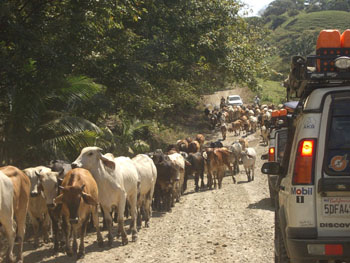
[Above: These Brahmans are actually a lot less threatening than Costa Rica's Number One road hazard: potholes.]
Today we woke up before the sun. In a few hours, we'd be crossing into the light.
My watch alarm beeped me out of my sleep at 0530. Our damp little cave of a room was just big enough to fit three twin beds and two bikes, carefully Tetris'd behind the door, but there was no space for our luggage. There were no windows, no A/C, and no escape for the foul odor produced by the mildew growing out of the walls, floor, and mattresses. The room stank when we checked in, and it stank when we checked out. Our static little environment had achieved equilibrium.
I rose before my roommates, Rolf and Todd, because I needed extra time to carefully place our two Santa Cruz mountain bikes onto our Bauer vehicle racks, and I wanted to have dibs on the shower. Today would be a border-crossing day, so our protocol called for a 6:00 a.m. departure.
We were all loaded and ready to go on time, and we got to do a little filming as we left the street our hotel was on. We waved goodbye to the friendly people and the beautiful city of Granada, Nicaragua, as we drove out of town past the bustling market, the festive town square, and block after block of incredible old Spanish architecture. We'd had a fantastic few days there, but we were heading for Costa Rica and her pristine beaches!
It was a short drive to the border, but the crossing took several hours. Leaving Nicaragua was a breeze, but entering Costa Rica was pretty painful. The lines were enormous. I couldn't believe how many people were there waiting to enter Costa Rica-and half of them were Europeans or Americans.
With a little "creativity", we were able to speed things up just a bit, and we got all four Land Rover Discoverys and all nine team members stamped and cleared in about five hours. And we were off!
Costa Rica is indescribable to those who have never seen it, so I won't labor too long in an attempt to explain a few of its details.
I was immediately struck by the contrast of affluence between Costa Rica and the rest of Central America. The dogs were fatter and healthier, the roads were wider, and the people seemed somehow different. It wasn't better, it was just different. For whatever reason, there were fewer roadside food stalls, fewer people walking along the main road, and fewer roadside neighborhoods.
With fewer living obstacles and road hazards to navigate, I could feel myself becoming more calm, but we couldn't really relax our driving at all for fear of the amazing Costa Rican potholes. They come out of nowhere, and they are everywhere. They are often wider than our wheelbase, and they can be deeper than the radius of our tires. It's a good thing we're riding on strong-walled BFGoodrich tires and steel ProComp rims. We haven't had any problems at all with blowouts or punctures (knock on wood).
Neil from our film crew lived in Costa Rica for four years from 1996-2000, so he was in the lead vehicle. We were heading to one of his old surfing haunts to camp on the beach. The drive was bumpy, twisty, and beautiful. As a Texan, I felt soothed by some of the wide-open cattle fields and the big white Brahma bulls with their long, lop ears. Where there wasn't a green cow pasture, there was rainforest.
We arrived at our destination shortly after nightfall, and we made a pit stop in town to eat at a restaurant across the street from Coconut Harry's Surf Shop in Playas de Nosara, Costa Rica. Harry, like so many other Americans, decided to leave the states for the tropical paradise and "pura vida", or "pure life", of Costa Rica to open up businesses. You can see Harry's at www.coconutharrys.com. In his display case is a photo of a home with a car in its driveway. Blanketing each is about four inches of snow. A hand-written caption reads "Why I Live in Costa Rica."
After dining on a "casado", which is the typical Costa Rican plate consisting of rice, beans, salad, and grilled fish, steak, or chicken, we headed for the beach. I had chosen the "pescado", and it may very well be the best fish I have ever had.
We parked our vehicles on the beach looking out to sea. Behind us was the rain forest, filled with tropical birds, lizards, monkeys, and zillions of spiders. (I know about the spiders, because I saw thousands and thousands of little eyes glowing at me out of the dark. They were reflected by the light of my head lamp.)
I slept well in our Hannibal rooftop tent, even though the weather was hot and humid. There was just enough of a breeze to keep me from smoldering. I fell asleep with the knowledge that tomorrow would mean a quick swim or surf in the ocean before the long drive to more surfing in paradise in the city of Manuel Antonio.
Nancy
nancy@drivearoundtheworld.com
P.S. - Border crossing took 4.75 hours.
| Logbook for December 4th | ||
| Start: Granada, Nicaragua |
Finish: Playa Nosara, Costa Rica N: 9* 56.29' W: 85* 39.993' |
Mileage: 229 |
December 05, 2003
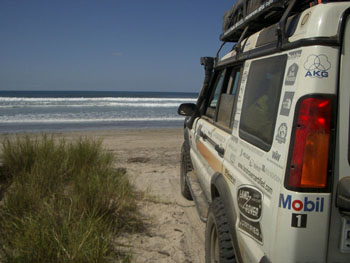
[Above: A Drive Around the World Land Rover camped out for the night at Playa Nosara, Costa Rica.]
Hello everyone,
Today, we are at Playa Nosara. It is a beach on nestled against the Pacific Ocean in Costa Rica. Today represents a homecoming of sorts. Today, we will be driving to Manuel Antonio. Manuel Antonio is a town that has experienced a great increase in popularity over the past few years. It has the unique distinction of being right on the edge of a rain forest, but also on the edge of the ocean. It is a very interesting climate combination that results in the balmy weather associated with a beach, but also the extreme humidity that you find in a rain forest. It is also a town where Neil lived for over 3 years.
This morning, I climbed out of the tent at 5 am so I could watch the sun come up and it's morning rays electrify the waves about 30 meters from our cars. It was such a beautiful morning, although it has been warmer than I care for. The heat and humidity continue to increase the further south we go, and right now we're about 8 degrees north of the equator. To put that into perspective, San Francisco is located at about 37 degrees. In order to take full advantage of this morning, I set up my video camera to record the sun rising and headed out to the beach to take some photos and collect some shells. After meandering for a good hour, I went for a morning wakeup swim in the ocean and bodysurfed for a little bit. Feeling refreshed, I returned to the beach and practiced my yoga. It was very peaceful to be the only person awake on the beach and have the ocean, the tropical forest, and the sunrise all to yourself. I have found that the constant state of flux and adjustment to living out of a Land Rover in new surroundings all the time can be quite draining. The team never really has a chance to adjust before we move on (we've been in 5 countries in the last week). As a result, I found myself reminiscent of the people I left behind. An adventure like this is an incredible experience, but most people don't realize that when you're this far from home, part of you tries to stay connected to home, even though you are trying to fully experience every country. On an expedition, you constantly have to adjust to news and events from home, though you're not there to participate. For me, this morning reminds me of a Costa Rican phrase, "pura vida". It's a greeting used by Ticos (native Costa Ricans) daily, but it's meaning is much deeper. It symbolizes "pure life", and it's something to strive for every day. In our own way on this expedition, we are all searching for our pura vida, and we anxiously await the next experience so we can share it with those of you who follow from home.
So to all of you, "pura vida".
Justin
justin@drivearoundtheworld.com
P.S. - The team split up today. One did river crossings, the other went ahead to set up camp in Manuel Antonio.
| Logbook for December 5th | ||
| Start: Playa Nosara, Costa Rica |
Finish: Manuel Antonio, Costa Rica N: 9* 27.059' W: 84* 08.987 |
Mileage: 089 |
December 06, 2003
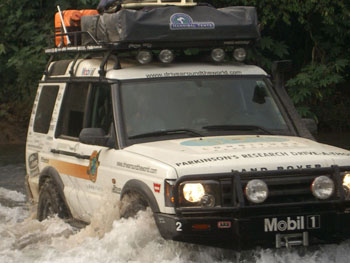
[Above: Drive Around the World Land Rovers cross some Costa Rican rivers en route to the town of Manuel Antonio.]
Being the jovial gent that I am, it recently occurred to me that someone is occasionally going to have to go out of their way to make sure that our little group is enjoying our journey as much as possible. It was with this theory in mind that I appointed myself to two new positions; secret Santa coordinator and vice-chancellor in charge of mustache wearing.
First and foremost, and of the most urgency, I have appointed myself to the exalted role of secret Santa coordinator. I'm sure everyone's heard of secret Santa, the yuletide game where everyone picks a name out of a hat and then has to buy a gift for that person. Anyway, at the Costa Rican border, in my most beautifully scripted calligraphy (cough), I wrote down the nine illustrious names for our nine illustrious team members on beautifully folded origami-esque pieces of paper (cough) and carefully placed them in a green and white baseball hat. The rounds were made and within ten minutes, every member had chosen his or her gift target. It had occurred to me that it would be extremely amusing if I just wrote my own name nine times so that everyone ended up buying me presents, but that was against my better judgment and only because I knew that not everyone would keep their secret Santa person a secret and I would get caught. However, all you kids should keep that in mind for next year when the holidays come around. So now all that's left is for everyone to buy gifts, and come Christmas morning, the yuletide joy will be spread.
I'm sure everyone is curious as to what exactly a vice-chancellor in charge of mustache wearing does, and the answer is simple. My new job is to make sure that by the time we get to Ecuador, all able-faced male members of the Drive Around the World expedition crew will be sporting a full-fledged soup strainer of a mustache. Now some of you would say "Colin; you, Todd, and Nick already have mustaches." Well, if you said that, you'd only be partly wrong, because I have scruffy beard, and Todd and Nicholas have goatees. Which are completely different than mustaches. The plan I have devised ensures that "if possible" all the men will have only mustaches and no other facial hair. Mainly I just want to do this because mustaches are funny and I want to take some pictures of me and all my buddies sporting cheesy mustaches. I realize that mustaches aren't "cool" and that they're not exactly in style in America, but they are in style down here in Central America and when in Rome…
I do think mustaches look stupid, but for some reason sometimes I like looking stupid -- it amuses me. Unfortunately, Rolf and Justin do not have the capabilities to grow proper facial hair so they can't enjoy this facial merriment, however Rolf has sworn he will attempt to grow what is know in certain circles as a "gobbler" which is basically a neck beard, and I guess that'll do. Anyway, I'm hoping we'll all have sufficient facial hair around the Panama canal because I think it would be funny if we all bought Panama hats and aviator sunglasses and did a proper photo shoot.
So, all you people out their in computer land, this is my message to you: Life is about one thing, and no, it's not money, and no it's not love, or sports, or crocheting, or collecting butterflies, or any of that crap. Life is about enjoying yourself. If it puts a smile on your face when you have a silly t-shirt or baseball cap on, or even when you glance across the room and remember that you have a ridiculous looking mustache perched atop your upper lip, more power to you. But then again, who would ever take advice from a guy whose traveling companions call him the corndog?
Happy Holidays,
Colin
AKA Corndog
AKA Spongehead
AKA El Gringo Loco
colin@drivearoundtheworld.com
| Logbook for December 6th | ||
| Start: Manuel Antonio, Costa Rica | Finish: Manuel Antonio, Costa Ric | Mileage: Rest Day |
December 08, 2003
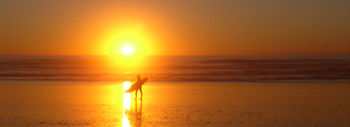
[Above: Surf's up!]
Wow, it is so nice to be back in Manuel Antonio! I spent about 2 1/2 years living here, and it was a spectacular time. To come back and see my old friends and experience the Pura Vida lifestyle of Costa Rica is a treat. I have been able to surf everyday and spend time with some good friends here. And of course, we have gotten some work done here as well.
Today, we awoke and went down to the beach upon sunrise and surfed for a few hours. The waves were small, but fun anyway. It feels so good and refreshing to be back in the water, especially water that is 80 degrees. Adam, Colin, and I surfed for a few hours at a beach called Playitas. It is a small beach at the north end of Manuel Antonio and has some fun waves. The coastline here is very dramatic, with palm trees, mango trees, guayaba, banana, and all kinds of tropical rainforest that literally comes down the mountain and touches the coastline. The palms actually lean over the beach as if they are trying to touch the ocean and drop their fruits right into the sea.
Amongst the rainforest here, the squirrel and howler monkeys come up to the beach as well. It is truly beautiful. You can see sloths, coatamundis, raccoons, anteaters, and all kinds of vibrantly colored birds. There is an abundance of wildlife. The sea-life is wild too, with crocodiles, hammerhead sharks, and many other wonderful sea creatures.
Manuel Antonio is also one of Costa Rica's largest tourist attractions, due to its famous national park and the picturesque location. So in the last few years, I can see huge developments going on around town. The banks are bigger, there are more houses being built, and everything is growing. It is a bit sad to see the pristine environment slowly dwindle away. Manuel Antonio does a much better job at maintaining their environment than many other Costa Rican towns I know, so that is nice.
Anyway, after we surfed in the morning, we went and ate breakfast at a beachfront restaurant called Marlin's, where a bunch of my friends work. One is a good friend of mine, who's name is Willy. I remember teaching him to surf when he was only 14 years old, and now he is 19 and competes and is a fantastic surfer! He is a great kid.
After breakfast, we went to go film a girl named Janine, who is originally from New York, and has lived in Costa Rica since she was four years old. She is now about 16, and when she was 9 years old, she started painting small rocks and other items to sell and save money to help buy and preserve local rainforest. So at 9 years old, she started an organization to help preserve rainforest. Seven years later, she has an office and a sanctuary where they help rehabilitate injured animals. She has also purchased a 5 acre plot of land nearby to set up an education center in the future.
In her sanctuary, she showed us some baby sloths they rescued, and also a squirrel monkey and some raccoons. She has to keep the squirrel monkey for a while, since once a monkey is out of a troop, they are not allowed to enter another. So she will slowly acquire a few more monkeys and form a troop, and then they can all go release into the wild together and live back in their natural environment.
It was really inspiring and sweet to see someone so young who has taken action to help preserve the rainforest. Children back home will hear of her through our education program and hopefully be inspired to do similar things and realize how much influence one person can have in a community, and how you can be any age to go for it!
Now we must all realize something extremely important here, and that is while we are filming and doing other fun things in Manuel Antonio, Nick, Chanda, Rolf and Todd were all locked up in their hotel rooms working on our website and various other writing and technical projects. In fact, the entire 4 days we were in Manuel Antonio, Chanda only saw the beach on the last day we were there. Todd as well, didn't see the beach, nor had desire to go, I guess he is not a beach guy. Justin was also in the internet cafe nonstop dealing with all kinds of public relations and logistical information. These guys are on top of it, and it should go noted that they work and work and work and work!!! It amazes me how focused they all are. Nancy, on the other hand, just drinks Pina Coladas and runs around the beach in her string bikini all the time (ha ha, just kidding, but if that ever does happen, I'll be sure to let you know).
So the rest of the day was spent eating, working, and surfing. It was a great day and I am so grateful to have the opportunity to be back in Costa Rica. It is like coming back home in a sense. It is so familiar and was such a large part of my life. I definetely will be spending more time in Central America in the future.
Neil
neil@drivearoundtheworld.com
| Logbook for December 8th | ||
| Start: Manuel Antonio, Costa Rica | Finish: Manuel Antonio, Costa Rica | Mileage: Rest Day |
December 09, 2003
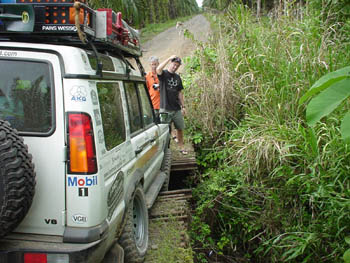
[Above: Two different angles of vehicle D1, which got stuck on a precarious bridge in Costa Rica.]
Manuel Antonio has been a well-received time-out from driving and filming. Neil and I have surfed everyday and at night we were guided by Neil-io into meeting some interesting characters. Late nights have turned the week into a more draining dose of entertainment than massages and suntanning (which were just what the doctor ordered).
The place is not an attractive town, and is rather cultureless in comparison to any of the other Central American towns and cities. There's a heavy dose of the ol' gringo here. Expatriates from the US, England and Australia seem to linger around, having never left since their exodus in the '60s and '70s. Week-long trips turned into decades, they set up shop on land that cost hundreds of dollars an acre and built homes for $15K with teak and almond-lined floors and ceilings. This has become a current bewilderment of mine and has lead to an obsession with the affordability of exotic hardwoods in the country. A few summers ago I was restoring my sailboat. Spending summer days and student loan leftovers, I quickly discovered the extortionate cost of teak, an oven-dried hardwood known for its resistance to the elements. After pondering the cost of $35 per foot of 1 inch by 8 inches, I decided to buy mahogany, a slightly cheaper option at $25 per foot. So, when I stared up at the thatched hut/roadside cafe and asked the owner how much one of the twenty, 30 foot long beams of teak cost he replied, $12,000 Colones -- $30. I never got over it.
The last day in Manuel Antonio we actually shot some video. Todd discovered a 15 year old who had started up a "save the rainforest" campaign when she was 9 and has been running it since. From a few dollars here and there it's grown into a very involved little campaign. She now has a small shop that sells souvenirs whose proceeds go towards rehabilitating injured or castaway monkeys and other tropical animals. She pulled out a box of two baby sloths that resembled "Animal" from Sesame Street. They spent most of their time hugging and smooching each other. We shot a quick interview with her and headed out to her parents' property for a little nature walk. She later revealed that the BBC and National Geographic had shot her before.
Later, Neil and I went surfing for almost 4 hours, and that evening we went back to the Mimo's hotel and discovered an excited Todd and Nick. Apparently they were off driving around the local hills in one of the Land Rovers, playing explorer. They had come across one of those little roads that Nick loves to venture onto and got into a little trouble. While traveling over the bridge, part of it collapsed under the weight of the vehicle. However, with three wheels firmly in place, recovery was as simple as gently backing up. I guess the lesson is to always be careful on the narrow country roads.
Adam
adam@drivearoundtheworld.com
| Logbook for December 09th | ||
| Start: Manuel Antonio, Costa Rica | Finish: Manuel Antonio, Costa Rica | Mileage: Rest Day |
December 10, 2003
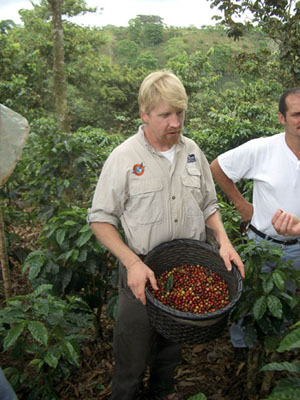
[Above: Todd learns the art of bean-picking at a Costa Rican coffee plantation.]
We have just spent the last couple of days in Manuel Antonio. It was nice to get a break from driving, but there was still much work to do. I faced a computer nearly everyday, but I feel a bit more caught up but still feel kind of ragged.
The wake up call was early, but we had coffee on hand to make the transition to wakefulness much easier. We were all occupying the same suite therefore we were all competing for the one bathroom that was available.
Without to much delay we packed our stuff and were on our way through the windy sloped roads that led to San Jose, the capital of Costa Rica. The drive was nice, with bananas to our right and left. However, due a late start we were unable to stop for breakfast, so we had to satisfy ourselves with little scraps of crackers and other snacks that we had squirreled away.
We arrived in San Jose a little after 11:00am and pulled into the Best Western. David Homa and Mary Hill, our support team in Los Gatos, had rounded up a box of stuff that we needed and sent it here -- or so we thought. We soon found that we were at the wrong Best Western and that the box had indeed arrived, but was stuck in customs. A company offered to help spring the package in a timely fashion for the modest fee of $300, but we had faith that our friends at Land Rover might be able to help us.
Since we were pressed for time, the team ducked into Denny's for lunch, as Nick and I were tracking down hotel details and contacting the Land Rover officials we were supposed to meet 30 minutes prior. We contacted Rudolfo, who was heading up Land Rover's newly founded coffee business, and he was our guide for the day. He decided he would come and meet us where we were, because it was on the way for him to go to our afternoon activity, a Costa Rican coffee farm.
His friend and fellow coffee colleague, Benecio, led the way to the coffee collective in the Naranja province of San Jose (named for all the orange trees in the area. It is interesting to note that the oranges here are green, as are the other citrus varieties, because it does not get cool enough for them to change to their final color).
We arrived at the finca (farm) and immediately went to work. The workers put a basket on Chanda, and we tried to fill what we could with coffee beans. Although an average worker fills a basket within 40-45 minutes, and gets paid less than a dollar for it, 5 five us couldn't come anywhere near this rate of one worker. They showed us all the steps of coffee harvesting and milling which is described in the educational section of this web site.
After driving through the coffee fields with the old and new Land Rovers, we ended up at the coffee mill, where we dropped off our super-caffeinated payload. Nick was in heaven as he drove a 1959 Series II Land Rover, pulling a load of coffee beans to the mill. Costa Rica is really Land Rover heaven. In fact they used to make them in Costa Rica, and Land Rover sold many of them to the coffee farmers here. Their mulit-purpose slender design made them perfect for working in the fields.
When we arrived at the mill with our beans we saw at least 5 other Land Rover Series 88's. In fact there is an annual Land Rover parade in this area. After touring the mill, I was allowed to drive the '59 Diesel back to our coffee-tasting venue. I jumped into the driver seat and Royas (our coffee farm guide) was at my side. I started the vehicle, and was ready to back up. However, before I was ready, Royas took off the emergency break and the car rolled forward. Unfortunately, the roll forward put us over the edge of an embankment. What was left of the edge of the pavement collapsed, putting me in further jeopardy. I was able to stop the car with the weak brakes, but the e-brake was certainly not strong enough to hold the car. Adam was immediately in my face with a camera to cover the drama. So with one foot on the clutch, a toe on the break, and a heel on the accelerator I was able to back up out of this threatening position. After driving to safety, I learned that this vehicle was the family's beloved vehicle, which they had bought new in '59. Whew, that could have been disastrous!
After negotiating the traffic at the mill, the Land Rover train made its way to our tasting venue. Benicio and Roya's mother Marta put out a spread for us. She opened her house to us and sat us down in her kitchen, serving coffee, tortillas, sweet bread and regular bread. Colin sat down next to me and asked me for the sugar. Much to his dismay, I passed him the salt dish, which looked like sugar to me. Colin was a bit perplexed when he took a sip, but we soon figured out the mistake as laughter spread across the table.
One of the best things about traveling is the people you meet. We had never met these folks before, yet they invited 8 strangers into their house and served us with warm hospitality and coffee. It doesn't get much better than that.
After about an hour we packed up and headed back into San Jose, and to our hotel -- Rudolfo guiding us the whole way -- through the rainy traffic-tied areas. We have a date with Land Rover tomorrow. Who knows what exciting things will be in store for us then!
| Logbook for December 10th | ||
| Start: Manuel Antonio, Costa Rica |
Finish: San Jose, Costa Rica N: 9* 56.308 W: 84* 04.904 |
Mileage: 263 |
|
Breakfast: Coffee |
Lunch: Denny's bacon cheeseburger |
Dinner: Coffee, sweet bread and quesadillas |
December 11, 2003
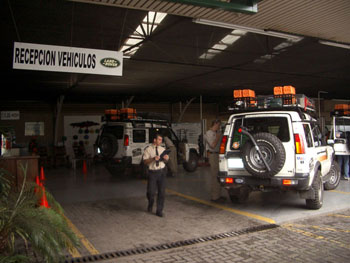
[Above: Drive Around the World Land Rovers are parked at a dealership in San Jose, where they underwent some routine maintenance.]
The team had an early start today, because today is Drive Around the World vehicle maintenance day at Land Rover San Jose. That's right, we drove for forty-one days, only to end up right where we started: San Jose (Costa Rica, that is.).
We arrived at the dealership at about 7:30 in the morning and were greeted by an enthusiastic and excited staff of employees. They had the entire mechanics' bay cleared and ready for us.
Todd had a list of items that needed to be addressed for each vehicle. It was basically routine stuff, such as condition the windshield wipers, adjust the headlights, balance the tires, and check the brakes and fluids. Our next opportunity for service would be Chile, and we wanted to make sure everything was good to go. The Number One thing you learn at a Land Rover driving course is "vehicle preservation." These vehicles have to get us all the way around the world, and we depend on them for everything. They are our most important equipment, and we treat them well. Not surprisingly, they have performed swimmingly. After all, they are Land Rovers; they were born and bred for this sort of stuff.
We stayed at Land Rover all day, and we were just blown away by the hospitality extended to us, especially by Rodolfo Echeverria, the chief of Land Rover Café, whose office is co-located with the service center. He worked extra hard to ensure we had everything we needed, and he even helped us with non-Land Rover errands, such as buying an inverter and picking up a package at customs. He is absolutely amazing, and I'm privileged to be able to call him my friend.
Rodolfo is a man who has found his true passion and is now making a living doing what he loves. He knows and understands the science and the art of producing the finest coffee in the world. His family has been in the business for more than 100 years. He is a go-getter, and I admire people with his integrity and work ethic. He's what I refer to as "good people." You should read more about Rodolfo and our trip to the coffee plantation at our education website.
At around 6:00 p.m., we were overdue at a reception at Motores Britanicos, which is the Land Rover building that houses the dealership. It's located only about six kilometers from the service center in San Jose. Well, it was rush hour, and that six kilometers took almost an hour to drive. I was having a blast, though, because driving in San Jose is akin to driving bumper cars. I got to use my most aggressive defensive driving skills. We poked and prodded our way through crazy intersections and bumper-to-bumper traffic like George Costanza playing Frogger (Seinfeld reference; my apologies.). Suffice it to say we did well, and no buses, trucks, pedestrians, motorcycles, or micro-machine-style vans could slow us down. I was feeling pretty stoked.
When we arrived at the dealership and saw the spread they had laid out for us, we felt even more stoked. The other three vehicles had arrived more than an hour ahead of us (Nick, Chanda, Todd, Rodolfo, and I had been delayed by additional business.), and they were parked inside the building in their big showcase room. We pulled right in behind them, and all four expedition vehicles were on proud display for the evening. An amazing chef was manning the barbecue, and he served up beef, chicken, and sausage tacos until we couldn't stand to eat another bite. I seriously don't know how he made them taste so good.
By 9:00, a pretty severe food coma was beginning to set in, and the employees had to get home to their families, so we had to wrap things up. It was no fun having to bid our new friends goodbye, but I feel pretty certain we'll see them again, perhaps in the States. Our host, Oscar Echeverria, owner of Motores Britanicos, and each member of his staff, are the type of people you just want to keep as friends forever. They are good people.
It was easy for me to sleep that evening, with the contentment of a full belly, new friends, and the anticipation of the next day's journey to the wilds of the Osa Penninsula wafting through my mind. Life is good.
P.S. - Visted San Jose Land Rover dealership for vehicle maintenance. Attended a BBQ with Land Rover employees.
| Logbook for December 11th | ||
| Start: San Jose, Costa Rica | Finish: San Jose, Costa Rica | Mileage: 11 |
December 13, 2003
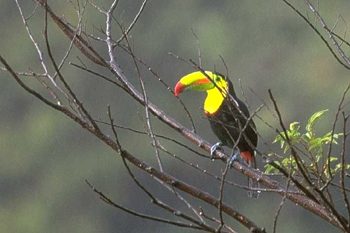
Hello everyone,
Today is the 43rd day of the LONGITUDE expedition. It's hard to believe we've been gone for a month and a half and that Christmas is 12 days away. We are continuing through Costa Rica, on our way to Panama and the Wallenius Wilhelmsen ship that will take us to our second continent and our eighth country. This morning, we met Michael Cranford, a local artist and rain forest conservationist for breakfast and a hike at his house. Michael has purchased and helped preserve approximately 200 acres of primary and secondary rain forest. During the hike, Mike pointed out many of the animals that are regularly found in the rain forest. We were lucky enough to see both toucans and scarlet macaws. These birds are not only beautiful because of their multi-colored plumage, but also because they are so graceful when they fly. The toucans were perched near the top of a papaya tree where they could easily access the fruit for food, and the scarlet macaws were incredible to watch, as they would swoop across the sky effortlessly. Surrounding the house, Mike has added feeding perches for monkeys. They are simple platforms mounted to the trees where he leaves bunches of bananas gathered from trees in his lawn. It is not uncommon, he said, for monkeys to come right up next to the house to eat the bananas both in the morning and in the evening. Unfortunately, we did not see any monkeys today, and Mike swears we are his first visitors to have that happen.
The Peninsula de Osa contains the second largest area of biodiversity, second only to the Amazon Rain Forest. The majority of the peninsula is contained in the Corcovado National Park. Through Mike, we were invited to a meeting for the International Campaign of the Conservation of the Osa Peninsula. The International Campaign for the Conservation of the Osa is a multi-institutional effort to raise funds for biodiversity conservation in the Osa Peninsula, in Costa Rica. Organizations participating in the campaign include the CR-USA Foundation (CR-USA), the Ministry of the Environment of the Government of Costa Rica (MINEA), Conservation International (CI), and The Nature Conservancy (TNC), together with local partners. The Campaign seeks to raise $31.5 million to consolidate protected areas, create biological corridors, and work with communities, local organizations and private landowners on the conservation of forests and wildlife on private lands. We joined approximately 50 local land and business owners to discuss the problems facing conservation efforts in Costa Rica. During this two-hour meeting, we met with Alvaro Ugalde, the Director of the Osa Conservation Area. He informed us that the greatest threats to the region are illegal forest cutting for the purpose of wood production and illegal hunting of large game animals, such as the puma. It was a very interesting meeting that allowed us to participate in a forum discussion on how the citizens of Costa Rica can band together to ensure that this unique natural habitat can be preserved and enjoyed for generations to come. Alvaro, we came to find out, is the man singularly responsible for the creation of Corcovado National Park.
After the meeting concluded, we were introduced to "Crazy" Mike Boston, an Irishman who was born in Trinidad/Tobago. Mike is a renowned biologist and conservationist, and he is famous for taking groups on nighttime tours to find crocodiles in the lowland waters. Mike invited us to join him for a night hunt. Everyone went to their vehicles to grab headlamps and flashlights to follow Mike into the swamp. It was incredible! Within ten minutes, we had seen over a dozen crocodiles ranging from 3 feet in length to 8 feet in length. At one point, we were even feeding the crocodiles from the shore. The largest one was no more than 3 feet away from us at the edge of the water. Mike taught us that the best way to spot a crocodile in the dark is to shine a beam of light right along the top of a body of water. If you are patient, you will see the reflection of the crocodile's eyes glowing in the distance. After spending about an hour spotting crocodiles, raccoons, and other things that go bump in the night, we returned to Mike's house to prepare for tomorrow's drive. It's our last border crossing in Central America-to Panama, and you know what that means…up at 4:45 and on the road at 6:00.
I hope you are all well.
Justin
Justin@drivearoundtheworld.com
P.S. - Team toured primary and secondary rain forest. Attended meeting with the International Campaign for the Conservation of the Osa.
| Logbook for December 13th | ||
| Start: Puerto Jiminez, Costa Rica |
Finish: Sombra de la Lapa, Costa Rica
N: 8* 33.060' W: 83* 23.442' |
Mileage: 8 |
December 14, 2003
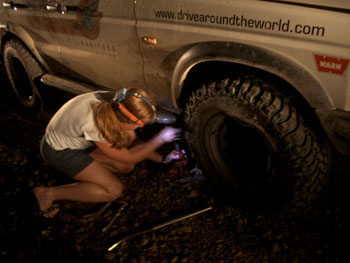
[Above: Nancy works at changing one of the two damaged wheels sustained by vehicle D2 in Panama.]
Panama is an interesting place to see from the side of the highway at night. I was driving the tail of the convoy with foggy contact lenses, fatigue, and some distracting photos on Neil's laptop. These roads in between the border and Panama City are under constant repair. They have an interesting process of road construction here, where someone leaves an empty and severely dented oil drum at the head of the lane in repair with no other forewarnings. Beyond that is no road and to the left, or right depending on what lane is removed, the two way traffic is forced into the same lane. Before I knew it the right wheels both veered off and dropped off the side of the road where it didn't exist. We dropped a good 12-18 inches and a "boom" so big you'd think we ripped the axle off. "Flump, flump, flop, flump," we bounced out with dual flats on the left and rolled to a shoulder as the rest of the convoy barreled on ahead. Neil and I immediately started laughing in disbelief at what had just happened. We couldn't find the walkie-talkie, since much of what we had arranged in the Land Rover had flown all over the place. I grabbed the camera and we circled the car assessing the damage. Tacos for rims front and back. The rear tire lay floppy and flat in the dirt shoulder, the front hissing like an angry snake. Soon we hear the crew call over the CB to see if we could hear them, then they arrived over the horizon of the nighttime two-lane highway. Hella bumper lights of three rigs in search of the "Minnow".
They got out in disbelief of the situation and couldn't believe what had happened to the wheels. They tried to ask what happened but I ignored them and hid behind the camera shooting their reactions. They all kept asking Neil if he did it, Colin came out of Justin's car and whispered to Neil, "You fell asleep at the wheel again didn't you?" He kept denying it all but was afraid to say I did it on camera because I have them all trained to pretend I don't exist when I'm shooting. So poor Neil didn't know how to react. Nancy went to work immediately jacking the car up. Nick and Justin argued about whether they should move the car off of the soft soil before trying to lift it. Justin was right, but Nick first tried to lift the low side that was leaning even more on the shoulder with a high lift jack. Later they moved the car to where Justin had recommended and they finished the job. It was ironic that the film crew blew the tires, created the drama and sat back to film them repair it, but it made for some good dramatic footage.
P.S. - LONGITUDE departed the home of artist Michael Cranford on the Osa Peninsula at 8:00 a.m. to drive around to the Costa Rica/Panama border. Team entered Panama via Paso Canoas. Border crossing took 4 hours. Neil had to play dumb to avoid having to give away coffee and money as bribes. "This is my country. I control who can come in. You need my signature..." Convoy continued East/Southeast away from the border, bee-lining it to get as close to Panama City and Colon as possible before stopping for the night. An unidentified hazard about an hour west of Agua Dulce caused Vehicle D2 to be sidelined with serious rim damage. Team replaced right-side front and rear wheels with spares from D4 and D2. Pit stop crew of Nick, Nancy, and Todd changed both in about 20 minutes. The roads in central america are ridden with pot holes so, when our director of photography went off the road into a deep gorge, the impact blew the bead on the right rear and severely dented both rims. Our BFGoodrich TA Mud Terrain tires, however did not sustain any damage. The documentary vehicle is now running on spares, but, once the rims are repaired, we´ll be back in business with the original BFGoodrich tires that began this journey. During Drive Around the World´s previous expedition, LATITUDE (1999), the team drove from Beijing to San Francisco without a single puncture. After a quick stop down the road for refreshments, snacks, and a hosing down of the sweaty and grimy pit crew, the convoy was back on the road. Arriving at a secure hotel in Agua Dulce at midnight they hit the rack immediately. (N.O.)
| Logbook for December 14th | ||
| Start: Sombra de la Lapa, Costa Rica |
Finish:Agua Dulce, Panama N: 8* 14.819' W: 80* 32.202' |
Mileage: 247 |
December 15, 2003
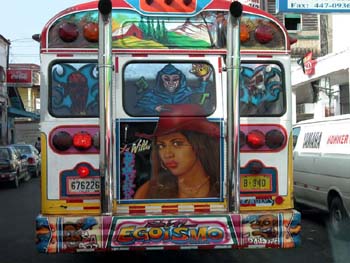
[Above: A colorful Panamanian commuter bus in Panama City.]
Today was a driving day again. We woke up around 7AM and were on the road by 7:30AM. We stayed the night in a very small town on the way towards Panama City. We arrived late and I was sleeping in the car at the time, and when we left, we were gone so quickly that I don't even know the name of the town we slept in. It was just a stop on the highway to avoid us being too tired at night and also to avoid having to arrive in Panama City late at night. We were also a bit behind schedule, since we had our small accident earlier in the evening and had to change two tires on our vehicle. It was a bit scary -- BOOM, BOOM -- and just like that we were staring at each other in disbelief at our bent rims and blown out tires. It was loud! But anyway, that was yesterday. So today we pushed into Panama City. It was a beautiful drive, passing through farmlands and at times, jungle and banana plantations. The landscape is similar to Costa Rica, but what really changed dramatically were the people. The people here in Panama have a very distinct Indian heritage, and you can see it in a large majority of the people. There are also a lot of African descendents as well. It is a much different ethnic makeup than in Costa Rica. And on top of the people looking very different, the humidity here is much more intense. It has been raining tons and it is like stepping out of your car into a steam-room.
Along the way, we saw a bus that had been in a crazy accident. The back of the bus and sides were completely smashed, and in the front, the entire hood was ripped off and smashed in. You could see the belts moving! The bus was also not lined up on it's chassis -- it was a bus driving down the road in a diagonal. AND, the roof of the bus in front was ripped off, so the driver had on goggles and was driving a beat up convertible bus! He waved as we passed by.
So we eventually made it to Panama City!!! Paaaaaaanama, Paaaaaaaanamahaaaaahooooooohaaaahaaaahoooooooo Paaaaaaaaaaaaaanama!!!!!!! (Thank you Van Halen!!)
As we arrived, we drove over the Panama Canal, which was an amazing canal to cross. It is enormous, we just passed it and haven't really stopped or been back to check it out yet, but we will. As we arrived into the city, I was blown away at the horrible conditions. Panama is much poorer than I had previously thought. There were buildings lined up with clothes strewn everywhere, and dirt and garbage and just really bad conditions. These are actually the worst conditions I have seen in a city so far this trip.
We found a hotel, called Marparaiso, and as we were checking in, a bus rolled up with 13 guys from Maryland who were on a surf trip over to one of the northern Caribbean islands. Unfortunately, they got skunked and had really small surf, oh well, it could be a lot worse.
After we got to our hotels, the customs official from our shipping company showed up and took our passports and car info to the local customs. Tomorrow, we finish the process with the police, then we go to put our vehicles on the ship to Ecuador!!!
We got our rooms, emptied our vehicles, and ate some food at a restaurant down the road a few blocks. The food was more typical American cafe style food, nothing special, but good enough to eat. Where's my gallo pinto though? This morning, there was no gallo pinto in our hotel restaurant. Bummer.
After dinner, we went into our room and watched the news to find out news about Saddam. You all know more about that than I do I am sure.
Then we just crashed out while doing some photo editing and writing, etc. So until the next Monday, ciao!
Neil
neil@drivearoundtheworld.com
P.S. - We started at 0745 this morning. As we were leaving the hotel in Agua Dulce, we met another American couple. Nick, of course, suspected them of being CIA. He suspects everybody of being CIA. There's no way they were CIA. They never are. We had an easy drive to Panama City, stopping just outside to visit an internet cafe. We had journals and photos to send to Rolf for the webpage. After a few hours and some lunch there, we continued on, the driving becoming a little tougher inside the city. Panama City is huge, and the drivers drive like they mean it. We fought traffic to keep the convoy together and arrived at our hotel at 1600 (4:00 p.m.) after only two or three loops around a few city blocks. Easier than it sounds. We had an initial meeting with our freight forwarder, so he now has the paperwork he needs to get our vehicles cleared for shipping. (N.O.)
| Logbook for December 15th, Day 45 | ||
| Start: Agua Dulce, Panama |
Finish: Panama City, Panama N: 8* 58.204' W: 79* 32.085'' |
Mileage: 111 |
December 16, 2003
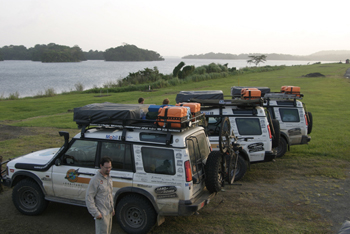
[Above: Drive Around the World vehicles overlook the Panama Canal near Colon.]
Today we were up fairly early to meet the Panama freight forwarder who has been helping us with our vehicle shipping paperwork. Two vehicles went with him to be inspected at the police station, and two vehicles went to the Panama Land Rover dealership to have D2's wheels and alignment inspected after the damage it suffered on the drive toward Panama City. Everything went well at both locations. Later, at the hotel, Nick, Nancy, and Justin had a conference call with Land Rover, members of the media, and friends of the expedition. All is going well, and vehicles are ready for shipping tomorrow. (N.O.)
| Logbook for December 16th, Day 46 | ||
| Start: Panama City, Panama |
Finish: Panama City, Panama N: 8* 58.204' W: 79* 32.085'' |
Mileage: 000 |
December 17, 2003
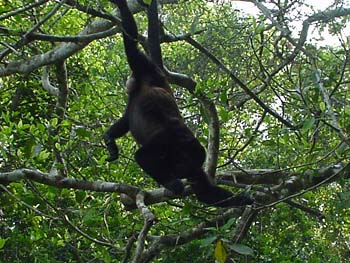
[Above: A howler monkey at play on Isla Barro Colorado.]
While everyone else had to drive the Land Rovers to Colon, Chanda and I threw on our educator hats and headed out to Isla Barro Colorado, a Smithsonian research site located in the middle of the Panama Canal.
Although we had to get up at 5:30am we both figured it was a better draw than having to deal with the vehicle bureaucracy. We stumbled out of the hotel just after 6:00am with our packs in tow. We were wearing long pants and boots and we were equipped with bug spray, water, cameras and a map. The arrangements were made hastily the day before, so we were at the cab drivers mercy and hoped he knew were he was going. Unfortunately I only had a rudimentary map that I could follow to navigate from the back seat.
He got us to where we were going and asked us if we needed a ride back. I hadn't thought this far ahead, so he had the drop on me. I told him I hadn't quite figured out what we were going to do, so he suggested he pick us up. He also warned me that if he comes all the way out here that we had better be here. I understood his concern, but said we would only wait for a half an hour beyond our meeting time, at that time we could do whatever we wanted. He understood that and we had a deal.
We arrived in Gamboa, where we would depart for the island, and grabbed some breakfast at a roadside stand. Meat and veggie empanadas were served with small cups of coffee. We all so had corn tortillas that seemed like corncakes, rather than the corn tortillas that we had been used to earlier.
Soon we were at the dock where we met the boat to take us to the island. Apparently the boat comes and goes only twice a day to take researchers and workers to and from the workplace. The boat ride took about 40 minutes, pressing north further into the canal, and finally ending up at Barro Colorado, an island that had been formed by the building of the Panama Canal.
After the flooding of the lake (which was the largest man made lake at the time), Barro Colorado remained higher than the waterline, thus it became an island.
Our tour group consisted of only six people, including Jim Malcolm (the English Ambassador to Panama). It was a great size as we could hike and see animals and not scare them away -- a liability of larger groups.
Anna, our guide, was great; she was informative and friendly. We hiked throughout the day and saw a lot of wildlife. We saw howler monkeys, toucans, agoutis, white-faced monkeys and many different types of plants and insects.
Altitude: Sea level
Breakfast: Empanadas and coffee
Lunch: Chicken and eggplant
Dinner: Lasagna
P.S. - Today we were up and ready in anticipation of loading our vehicles into containers for shipping around Panama. Unfortunately, we arrived at the port after quitting time for the paper shufflers, and we will have to try again tomorrow. (N.O.)
| Logbook for December 17th, Day 47 | ||
| Start: Panama City, Panama |
Finish: Panama City, Panama N: 8* 58.204' W: 79* 32.085'' |
Mileage: 079 |
December 18, 2003
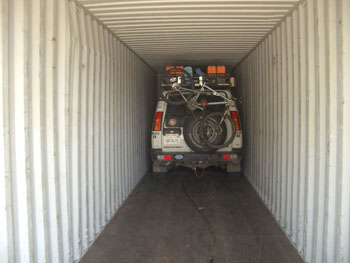
[Above: Nancy's D3 vehicle sits in a cargo container, ready for the overseas haul to Ecuador.]
Today is SUCH a good journal day, boys and girls! I have the loading of our vehicles to discuss, and, as if that weren't enough, I get to tell you about five sardines and their journey down the most pothole-filled road IN THE WORLD toward a little Caribbean island called La Isla Grande. Doesn't that sound like fun? Of course it does! Now, let me begin by apologizing for the tardiness of this journal entry. I have a wonderful excuse! (OK, ok, all you military friends out there. I realize that "I have a wonderful excuse" isn't one of the Naval Academy's preferred "Five Basic Responses", but I really do have a doozie. Allow me to share.) I could not write to you fine people because I have been on an island where they have NO INTERNET (eeegads!), very few televisions (the horror!), and two broken-at-the-time (pay) telephones (have mercy!). Story in a moment.
This morning, our departure time got bumped back from the scheduled 0800, as our vehicles (In my head, incidentally, this is pronounced [ve-HIGH-cles], which is an inside joke shared between myself and my dear Russian friend, Sergey, whom you will meet when we reach, uh, Russia.) weren't due in Colon until 11:00 or noon. Colon is only one hour from our hotel in Panama City, so we weren't in a rush.
Still thinking we were departing at eight, I dashed off toward a banana stand and an ATM. At the bank, two blocks from our hotel, I withdrew some cash and then listened to the machine beep at me to take my card while I carefully placed the money in my little change purse. Well, durn it, I waited one beep too many, because just as I went to grab the card, the evil bank machine retracted it into its bowels, because it had been identified as "lost or stolen." You see, boys and girls, if you try hard enough, a simple trip to the ATM can become an adventure…I even had an unkempt shoe-shine man raise his eyebrows and blow me a provocative kiss on my way to the machine…
Well, now what?! I went around to the front of the bank to see if I could speak to someone inside, but I was barred from entering by the armed security guard behind the door. He motioned to the sign that indicates they open at 8:00 a.m. It was only 7:45. "Cerrado," he said. "Quince minutos." Well, no kidding! I realize you are closed and won't be open for 15 minutes, but your evil machine just ATE. MY. CARD!!! And I'm supposed to be leaving in quince minutos!!!
I grumbled my way back to the hotel, sans card, to tell my team I'd have to return to the bank at eight to retrieve my card. Luckily, the team had decided to leave at 10:00. So Justin and I went back to the bank, and I told the guy inside what had happened. He said I'd have to go to some other location to retrieve it. "Why?" Because we don't know whose card it is. "I have three forms of I.D., and a receipt." You'll have to show those to the people in the other building. I can give you the address. "When will it be there?" We will send it, and it will be there Monday or Tuesday. (A couple of tears, and then I fire for effect.) "I'm leaving today, and we're driving around the world for 9 months andthisismyonlysourceofcashfortheentiretriphaveaheart!" One moment please.
He takes my passport, disappears for a few minutes, and comes back. Please wait over there -- you're going to get your card back. (Inside, I am dancing.) I continue wearing my "the world is coming to an end" face until I am safely out of the building with my card.
When we arrived back at the hotel, we discovered that Nick had contacted Red Bull and we were waiting for Analissa to deliver 15 cases. Awesome. We'd be able to ship it with the vehicles and not have to worry about how to get it to Ecuador. Yesterday, we were going to have to fly it to Ecuador. Today, because our vehicles didn't get loaded yesterday, we are able to solve the Red Bull problem. Red Bull Panama's Analissa arrived and loaded us up with 375 cans. (THANK YOU HAYES AND ANALISSA!!!) After a few photos and lots of thanks, we were on our way.
The shipping yard in Colon (Panama's second-largest city) is a giant chunk of land on the Caribbean Sea crowded with huge cargo crates of different colors stacked into towering rows. A giant crane runs around like a wasp, grabbing boxes and moving them from one stack to another. We arrived at 12:45.
At 2:00, we were finally on our way to the inspection area inside of a giant warehouse in the yard. There, a guy in an orange loading suit listed the contents of our vehicles and double-checked the VIN numbers and registration. Everything was in order, so we were directed out to wear two gigantic, empty steel crates that were waiting to be loaded with our precious cargo. Each would hold two of our Certified, Pre-Owned Discovery Series II expedition veHIcles. I drove mine in first, and Adam filmed from the passenger seat. As we squeezed out through the driver-side door, which could only be opened a few inches, we remarked that it was a good thing we weren't a little fatter or we'd be stuck inside for the long haul.
By 4:00, we were finally loaded and ready to leave. We had been delayed for almost an hour waiting for someone to come and lock the containers. We were told not to worry, that those guys would be here in the morning…So we used our own locks and had the guys attach tamper-proof tags. They would inspect things in the morning.
The film guys (Neil, Adam, and Colin) and I piled into a tiny little Diahatsu with all of our bags and surf boards to drive to a choice surf spot on a little island called Isla Grande (which means BIG island??) with a new friend of ours named Janet. She's a local surfer chick who is a friend of a friend of Neil's. Three people do NOT fit comfortably across the back seat of that little car. Trust me. We bumped along in excruciating discomfort down a really windy, pothole-riddled road for more than an hour, packed in like sardines, before arriving at the little beach where we would park the car. When Janet opened the door, we came pouring out with all our gear, as if the floodgates had been opened.
We paid to park behind a secure gate, and then we loaded into an awesome little 20-foot boat to ferry across the inlet to the bay to the island. The boat ride was awesome, and it made me miss my brother and my parents and our annual trips to Pensacola, Florida, to fish in the Gulf of Mexico.
On the island, we found a guy with a room with five beds, a kitchen, air conditioner, and a covered porch. We checked it out and determined it was a complete dump, but we accepted it because it was 30 bucks per night. Six dollars each ain't bad. I think the guy kicked his family out when we got there in order to rent it to us. There were clothes in the bureau, toothbrushes on the sink, no toilet paper, and a dirty sheet on my bed. He gave me a new sheet and we called it a night. I built a pillow out of my underwear bag and a shirt, and I cocooned up in the new top sheet. All night, I dreamt I was being eaten alive by bugs, and I tossed and turned until the A/C shut off at 7 a.m. We only rated the luxury of cold air between the hours of 8 p.m. and 7 a.m. But that's another story, and another day. I'm only here to write about Thursdays…
Merry Christmas, my friends. Be safe.
Nancy
nancy@drivearoundtheworld.com
P.S. - The team successfully loaded the four Certified, Pre-owned Discovery Series II expedition vehicles into two high containers at the port of Colon today. They are ready for a ship bound for Guayaquil, Equador. All of this shipping is courtesy of one of our premier sponsors, Wallenius Wilhelmsen Lines. Thanks, Wallenius! We will fly from Panama City to Quito, Ecuador, and then meet the vehicles in Guayaquil in about 6 days. (N.O.)
| Logbook for December 18th, Day 48 | ||
|
Start: Panama City, Panama N: 8* 58.204' W: 79* 32.085'' |
Finish: Colon, Panama N: 9* 20.992' W: 79* 54.097"? |
Mileage: 080 |
December 19, 2003
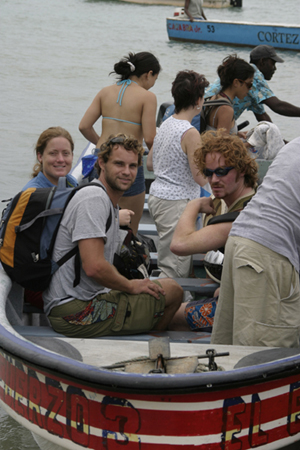
[Above: Nancy, Adam, and Colin onboard the boat that took them to Isla Grande, Panama.]
Hey all, I just got back from spending an extremely leisurely 4 days and 3 nights on?beautiful Isla Grande, off the Caribbean coast of ¨Panama. Contrary to its name, Isla Grande is TINY and consists of not much more than a few hotels, some private homes, a couple of stores and a few restaurants.
You may be wondering,"Colin, now what did you do on Isla Grande?" and my only answer is nothing. And I loved it. I just sat there and relaxed in a hammock and read. I read two books: The Razor's Edge and Tuesdays with Morrie, and I feel like I learned a little from each?of them. I also struck up a friendship with the owner of one of the local?resaurants, Carlos, and had some good conversations with him. I ate fish, I ate octopus, I ate seafood soup, I tried some handline fishsing, and I slept a lot. It was just what I needed before my return to the Drive Around the World fray.
And now on tuesday the team flies down to Ecuador to spend our holidays.
Colin
colin@drivearoundtheworld.com
P.S. - With the the Certified, Pre-owned Discovery Series II expedition vehicles successfully loaded into two high containers at the port of Colon, the team geared up for some R&R. The team split into two groups, with Nancy, Adam, Neil, and Colin going to Isla Grande to enjoy the sun and surf, and Nick, Chanda, Todd, and Justin exploring the sights in Panama City. Everybody is happy. (N.O.)
| Logbook for December 19th, Day 49 | ||
|
Start: Panama City, Panama N: 8* 58.204' W: 79* 32.085'' |
Finish: Panama City, Panama N: 8* 58.204' W: 79* 32.085'' |
Mileage: 000 |
December 20, 2003
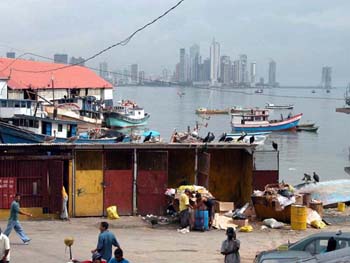
[Above: The skyline of modern Panama City as seen from the Old City; a door in the Old City.]
They say "the waiting is the hardest part". I think these words were originally spoken in reference to love and a long-distance relationship. Which I have always found to be true in life, but I suppose your experience may be different, depending on your unique set of circumstances. However, I'm not here to do a deep, philosophical analysis of Tom Petty lyrics; instead I'm here to challenge this statement. In fact, I believe that this phrase takes on an entirely new personality and meaning when used as a descriptor for an expedition. I'll tell you why in a minute.
As we prepare to conclude our second month of travel, I took a minute to reflect on our journey so far. Here's what I came up with:
We have been gone for 50 days.
We have traveled through 8 countries.
Right now, we are almost 25% done with our circumnavigation of the world.
There are approximately 31 weeks of travel remaining.
We still have 9 people traveling with us (which means no one has killed anyone else yet).
We are about cross the equator for the first time.
We spend a lot of time waiting.
Let's think about that last one for a second. We spend a lot of time waiting. Waiting at borders. Waiting for boats. Waiting for traffic to clear up.
Waiting...
Waiting...
Waiting...
Take now, for instance. We are in Panama City, Panama waiting for a ship to take our 4 Land Rover Discoverys to Guayaquil, Ecuador. Now the ship has already sailed -- literally -- but that leaves us with time on our hands. But time on an expedition has a rubber band effect. It seems to expand and contract at will. It moves too slow when you can't be doing whatever it is that you want to do. Yet, when the time comes to do whatever you do want to do, it goes by very quickly. Much like childhood.
We are often placed in situations where we are at the mercy of other people's schedules. Normally, this occurs at border crossings. However, it also happens when changing continents. The vessel that is transporting our cars was supposed to leave on the 18th. It left on the 19th. It was supposed to take 6 days for the ship to reach Ecuador. If you do the math, that's Christmas day. Now between you and me, what do you think the odds are that the dockworkers will be there Christmas morning to unpack our cars like Santa unloading his sleigh? Yeah, that's what I thought, too. Not a chance. So, if we can't get the cars on the 25th (not that we want to -- hey, we have to have Christmas too, you know?) we probably can't get them on the 26th either. A lot of people will be taking 4 days off. I can't blame them -- they all deserve a break. So now, we will be picking up our vehicles on the 29th. And at that point, time will snap back in the other direction putting us behind schedule and running at full speed.
But that's okay. Really, it's okay. And let me tell you why.
Waiting is sometimes it's the only time you get to yourself. It's your time to catch up. It's your time to slow down and relax. Or it's your time to do whatever we need to do. So, I decided that today was my day. I started my day by meeting Edwin Chan, our shipping coordinator, at 6:30 am to go golfing at Horoko Resort. It was an early wake up call since I didn't go to bed until 4:30 am, but how often do I have the chance to go out in Panama and shoot 18 holes the next morning? We hit the course at 7:00 am sharp. The course was beautiful, although it did have a haunting feeling to it. This course was built for U.S. soldiers who used to watch over the canal. Now many army-style buildings line the course with no occupants. Panamanians seem to be split 50/50 on whether the U.S. turning over control of the canal has turned out to be a good thing or a bad thing. Since the U.S.'s departure and the military evacuation, Panama's middle class has virtually been wiped out. There are now only two classes--the "Ye-ye's" or rich people and the "Raca-taca's" or the poor of the city. It is an interesting dichotomy and to hear the varied opinions always sparks a lively conversation. I wish I could share a photo of the view with you, but in my haste out the door, I forgot my camera. And if you're wondering, my game was terrible, just like it always is. I shot in the 100s.
But what does all of this have to do with waiting? Well, I was on the golf course waiting to play through the 13th hole. And to my left, there was a view that will stay in my memory forever. From the tee box, there is an incredible view over the bay toward the financial district. I literally stopped in my tracks to soak in the view and fully experience that moment. I also considered how lucky I am to be here. And that is where the waiting is the best part. If it weren't for waiting on a ship going to Ecuador, I wouldn't have had the chance to go golfing. And if I weren't for waiting at borders, I wouldn't have the chance to interact with all the wonderfully unique people in our world. And if it wasn't for waiting, I might just miss something special.
So, while I'm still not qualified to make a definitive statement with regard to love, I can categorically tell you that waiting on an expedition is really where the magic happens. So, the next time you are waiting, take a look around to see what magic is going on in your corner of the world.
Until next time, Feliz Navidad from Panama, ya'll.
Justin
Justin@drivearoundtheworld.com
P.S. - Another day without our vehicles. It feels...weird...empty. The team is still split between Isla Grande and Panama City. One group is on Gilligan´s Island, the other is in Hell´s Kitchen. (N.O.)
| Logbook for December 20th, Day 50 | ||
|
Start: Panama City, Panama N: 8* 58.204' W: 79* 32.085'' |
Finish: Panama City, Panama N: 8* 58.204' W: 79* 32.085'' |
Mileage: 000 |
December 21, 2003
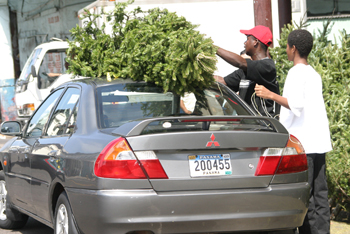
[Above: Enjoying the tropical Christmas season, a Panamanian prepares to take an American-style Christmas tree home from the market.]
Slow day. Humidity slows you down when you're not used to it. We've been here a week but still, I wonder how many days we'd need before getting used to it. The energy level within the team seems a bit lower than normal. Maybe the climate is making everyone tired or maybe we're all homesick -- it is Christmas time after all.
I worked on a new web page for our sponsors. It's interesting comparing this?expedition to our previous one. Last time we took older land Rovers. They were 40 years old, and we had only a few sponsors who supplied products like Michelin and Lonely Planet. This time we have over 30 sponsors -- each one of them we are very grateful for -- we wouldn't want to do it with out them. If all goes well and we have a decent internet connection this week in Ecuador, we should have the new web page posted soon.
Took a walk and used "the force" to decide where we'd go. Nick and I headed west and stumbled upon a large cathedral service. Inside there were statues of Mary and Jesus and the saints. Huge pillars, rows of pews, chandeliers, and decorative tile and mosaics everywhere. A nativity scene of Christ's birth was set up in a corner -- somebody put their heart and soul into building small village scenes complete with animals, wise men, and of course, Joseph, Mary and the baby Jesus. The models reminded Nick of scale villages through which a model train would run so I pictured the scene with conductors and track all around but it didn't seem like this would fit.
Went to McDonalds. It's always fun to checkout a familiar chain's Latin counterpart. Burgers (hamburguesas) are 39 cents -- they sell cheese-sticks and empanadas too. In Guatemala, one McDonalds was still serving the McRib -- I wonder if they missed the memo...
Chanda
chanda@drivearoundtheworld.com
P.S. - Day Three without our vehicles. Still feeling strange. We miss them! The team is still split between Isla Grande and Panama City. We'll fly to Quito in a few days. (N.O.)
| Logbook for December 21st, Day 51 | ||
|
Start: Panama City, Panama N: 8* 58.204' W: 79* 32.085'' |
Finish: Panama City, Panama N: 8* 58.204' W: 79* 32.085'' |
Mileage: 000 |
December 22, 2003
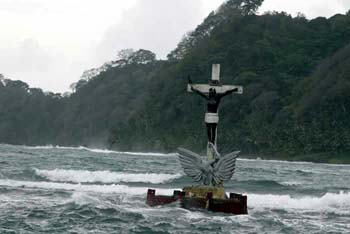
[Above: A dramatic crucifix in the surf off of Isla Grande.]
As the morning sunrise started to fill our room, I awoke, put on my reef booties, grabbed my surfboard and started to walk along the edge of the island towards a beautiful surf spot. It was very quiet out, with a light breeze and overcast gray clouds filling the sky. Jesus Christ was chilling out in front of the island as well. He was standing about 12 feet tall, in a solid statuesque state and holding his hands out in his classic pose, letting the Caribbean Sea tickle his toes. As I walked on, I also saw some huge crabs running across the pathway to the sea. These were the lucky ones, the fortunate little crabs who decided to cross the road early in the morning. I am sure they had no idea of the horrific slaughter their comrades were a part of the previous night!
Their poor buddies the night before were dumb enough to try and hang out in the middle of the road by the park where all the local island boys were playing. And what did the little boys do when they saw senor crab trying to cross the road? Well, what any island boy does, they all chased crabbie and kicked him a few times, then picked him up and chased the local girls with him. Now at least Crabbie had some fun chasing girls in his last moments. For what happened next, he even probably enjoyed as well. The sensation of flying is usually only know by birds and some crazy humans, but in this case Crabbie was flying too! He flew straight up into the air and was loving it, ascending at a rapid pace, like a rocket ship -- sshhhewwwwwwwwww!! Then he must have gotten the weightless butterfly stomach feeling near the top, and then enjoyed the breeze through his claws on the way down. What a ride! He really must have enjoyed it all the way until the bitter CRACK, when he reached terminal velocity and smashed the road. Oh well, fate has it out for some of those crabs.
So it was really pleasing to see these crabs in the morning cruising across the road and knowing that they were going to survive, at least for a little while longer. As I continued on my walk, I passed a few cabinas and restaurants, all very colorful, and very empty. It was just before Christmas and not many people were traveling to the island yet, which was a blessing for us. There were also many boats along the shore, some for fishing, and some for taking people to and from Isla Grande and the mainland. The shore was lined with palm trees and many other tropical flora and fauna. The birds were singing and it was extremely serene and peaceful.
After walking about 200 meters, the small town ended and a path along the rocks and shore began, which wrapped around a corner and into a small cove, which is where the waves were breaking. It was beautiful, and just as I rounded the corner, the wind picked up and it started pouring rain. And this was no ordinary rain, this was a slamming downpour! I went and tucked myself under a nearby roof on an uninhabited porch and sat there, stretching and watching the surf for a while. I waited for about ten minutes, and then I went and walked down to the shore. There wasn't a soul in the water and I hadn't surfed this spot before, so I was trying to figure out the best way to paddle out, since it was a reef break and you could see the waves pounding onto reef, and just inside of the impact zone, was the entire part of the reef that was only six inches to a foot deep. So I had to walk on the reef, as lightly as I could and try to avoid puncturing my feet with sea urchins. So the reef dance began. I danced my way out to a deep enough part of the reef where I could jump on my board and paddle quickly before a wave came and pushed me into the shallows.
As I paddled out into the waves, I was overcome with the joy of the scent of the Caribbean Sea. The Caribbean Sea has a very unique smell, and I adore it. I have surfed many places all over the world, and whenever I come to the Central American Caribbean Coast, the unique smell is a wonderful dose of nostalgia for me. Man, life is good when you are paddling out into the beautiful ocean, smelling the sea, and all around you are tropical hills and breaking waves. There is nothing like it in the world. And then to actually catch a wave and perform with it is truly heaven on earth. It is really hard to describe, since no matter how I describe it, it will really give no justice to what it is like. You really have to know how to surf to understand. But I guess I could say it is like dancing with Mother Nature. You are moving your entire body in motion with the ocean, exerting all your physical energy, while being completely mentally focused on every detail of your movement and the wave's. You are expressing yourself with unbridled joy and ecstasy. It is so amazing! You are in tune with natural energy. People harness the energy of moving water to create electricity, and we all use energy in different forms. But imagine being able to actually ride natural energy that has not been tampered with by man. And not only just ride it, but be able to move along with it gracefully and dance. It is ridiculous. And the coolest thing is that the better you get at surfing, the better surfing gets. I have been surfing for over 15 years, and to this day it is still getting better and I am more stoked that I have ever been. I have tried many other sports, but there is something extremely unique and special about the ocean's energy and being able to share intense pleasure with it. It isn't even a sport to me -- it is a way of life and meditation. It is healthy and exquisite to be able to step off of land and enter a completely natural surrounding. I mean, how often do you get to go and surround yourself with nature, filled with wildlife? And being surrounded by wildlife is amazing alone; however, when you are surrounded by it, submersed in it, AND, you can actually ride it and flow with it, that is truly the most real, intense, and beautiful experience I know.
So I paddled out and ended up catching tons of waves and had the time of my life. It was awesome! The surf itself wasn't the best I have seen, but it was overhead and super fun. And to be surfing on this tranquil island was just a very relaxing experience.
I ended up surfing for two days, all day both days. Adam came and joined me for much of the surfing as well. We had a great time. The tropics are really fun to surf in as well because the weather is so erratic. It would storm and throw down heavy rains, then the sun would pop out and brighten up the hills into a bright lime green color. The water changes color dramatically when the sun comes out as well. It becomes a lighter blue and you can see down to the reef. It is wonderful. Rainbows always find themselves amongst the surroundings as well. Truly paradise.
Now as a group, we are traveling, on the road and working most of the time, yet every once in a while, we have time to split up and just do our own thing for a day or two, and that is when I try to head to a surf spot. So this trip to Isla Grande was just that, a nice little relaxing getaway. Nancy, Colin, Adam and I went to the island together. We ate fresh octopus and drank tasty pineapple juice. The people on the island were very friendly as well. We ate at a Carlos' restaurant the first night and went back for each meal. He was an African Caribbean Islander and a wonderful person, we were lucky to find him. Thank you Carlos.
Well, back to Panama City and then onward to Quito, Ecuador for Christmas. Merry Christmas everyone, I send a huge hug to you all.
Oh, and in case you were wondering, this is Pancho Sanchez (see below) writing to you all. I took Neil's spot a few days ago.
Ciao,
Sanchez
P.S. - Day Four without our vehicles. The team has been reunited in Panama City. Tomorrow, we fly to Quito! South America, here we come! (N.O.)
| Logbook for December 22nd, Day 52 | ||
|
Start: Panama City, Panama N: 8* 58.204' W: 79* 32.085'' |
Finish: Panama City, Panama N: 8* 58.204' W: 79* 32.085'' |
Mileage: 000 |
December 23, 2003
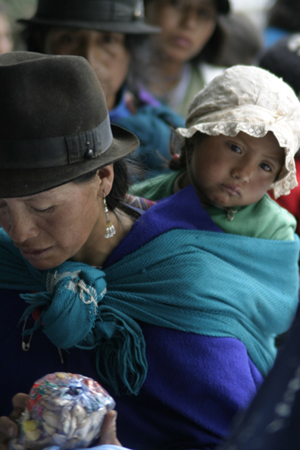
[Above: An Indian woman and her child on the streets of Quito, Ecuador.]
I'm laying belly down on the top bunk of a hostel in Quito. The boards pierce me in different segments of my extended body through the terry cloth sheet that covers a soft piece of foam. The frame is a crude design banged together by someone who's last name was not Carpenter, although I'd have to say I've seen very few college style bunks constructed with fine-cut, exotic mahogany. But then again this is Ecuador, so if it were Douglas fir or redwood then perhaps I could then label it "exotic". I don't even know anymore. The sun has just dropped. Justin says it falls faster at the equator than back in California because there are even hours of day to light. It didn't make any sense to me but perhaps there's some validity. It falls over the horizon in almost a perfect tangent, so maybe there's less of an angle for it to dilly-dally as it goes. Its cool here and the air is dry. A refreshing change from Panama, it allows for clothes to last more than half a day before they are shot, but only makes adapting to the tropics harder once we return to lower elevations.
Fortunately, we had an evening flight to Ecuador. My last days in Panama were spent hanging out with Neil and a couple of local Panamanians, a COPA airline stewardess from Bolivia and an Indian. We had a surplus of bombas left over from Nicaragua, so we decided to send a few into the air around 3 a.m. in Panama City. We headed off to a little park in a nice quiet part of town and tromped up to the top of the hill where there was a nice clearing. Neil placed the mortar on the grass as we stood a few feet away. I handed him the racquetball-sized bombas with a 12-inch fuse and he plopped it into the long tube. The fuse went with an impressive sparkle and it was off. A deep "Boom!" sent it barreling into the night sky, it then exploded into thousands of red and white bomblets that screamed through the air. As the concussions came to an end, the blissful silence quickly transformed into hundreds of dogs barking. Like a finely tuned mortar team, we loaded up round two: another screaming boom and then to round three. We decided to save a few and casually headed out together containing a childish sense of accomplishment. It was just about that time that we noticed the Panamanian policia running over the top of the hill with his hand on his gun. We tried to ignore him, but it didn't seem to work since in front of us pulled up three more in a squad car. They seemed pretty angry. Things eventually turned out OK, and later we found out that the Panama City mayor lives at the top of the hill. Perhaps that prompted the police reaction. Mental note: don't light fireworks off near government gardens.
The next day we were scheduled to fly to Quito, Ecuador at 6 p.m., so Neil and I spent the whole day swimming at a 5 star hotel that overlooked a huge canopy of rainforest on all sides. Coincidentally we were flying COPA Airlines, so when we got to the airport we bumped into our stewardess friend, who was headed for Havana, Cuba. The flight to Quito was pretty smooth, although I hate flying. I constantly wonder when we're going to plummet towards the Earth in an inverted dive; its one of my biggest fears. I'm not afraid of little planes, but the thought of roaring downwards for over a minute with screaming women and children freaks me out. The landing was considerably hard and bouncy but I soon forgot about it when the doors to the plane opened. We were welcomed by our first dose of pleasantly cool air from the high altitude of Quito. At something near 9,000 feet high, Quito offers a surprisingly fresh climate, despite being 22 kilometers from the equator. We're staying in "Gringolandia" -- a name given by the locals for a section of the city overrun by travelers from the US and Europe. We'll have to see what it offers tomorrow.
Adam
adam@drivearoundtheworld.com
P.S. - Day Five without our vehicles. At 4 p.m., the team hopped a flight from Panama City to Quito. It was amazing to step outside of the terminal after our arrival and into the cool, refreshing night air of South America. Quito is at about 3000 meters, or 9500 feet above sea level. We were shocked to feel the brisk air after being subjected to the heat and humidity of Panama. This marks the teams entry into the continent of South America and our first crossing of the Ecuator. So far, we´re digging the S.A. (N.O.)
| Logbook for December 23rd, Day 53 | ||
|
Start: Panama City, Panama N: 8* 58.204' W: 79* 32.085'' |
Finish: Quito, Ecuador N: 00* 13.019' W: 78* 30.004'' |
Mileage: Lots of flying... |
